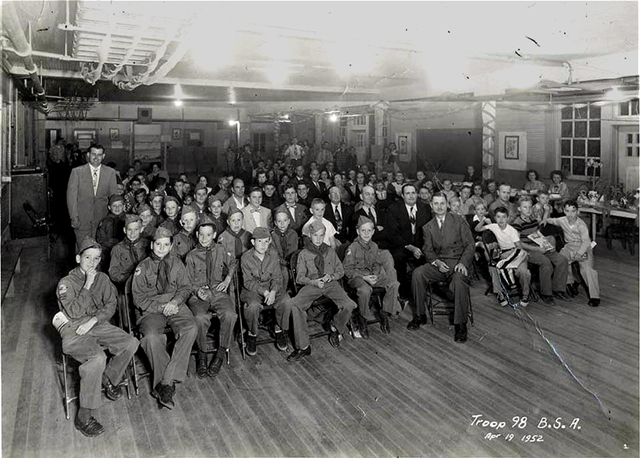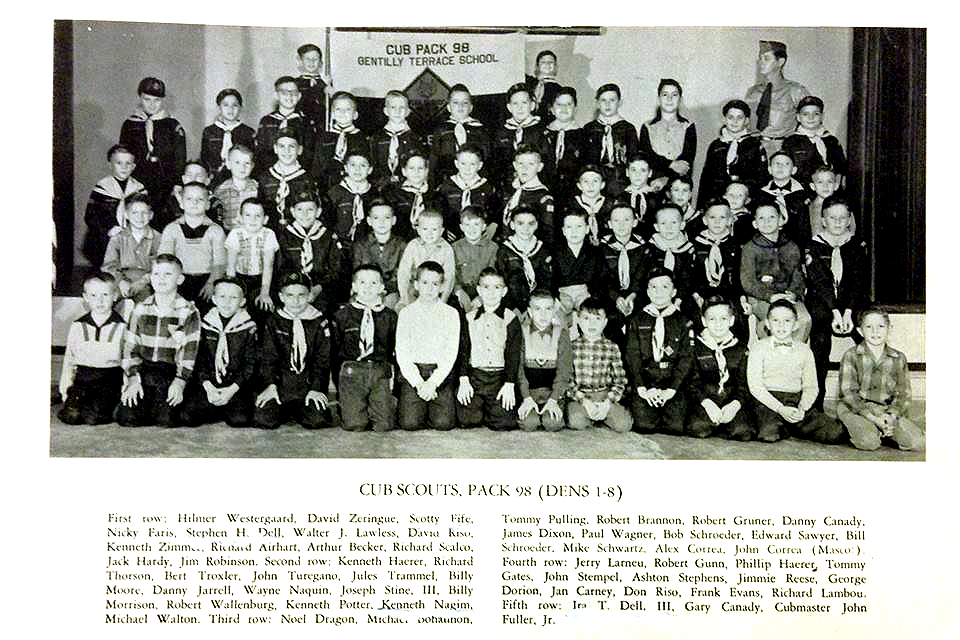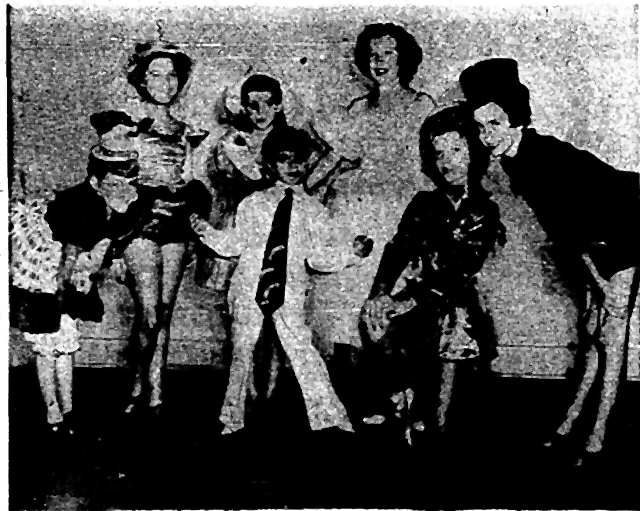GENTILLY TERRACE ELEMENTARY SCHOOL
IN THE 1950s
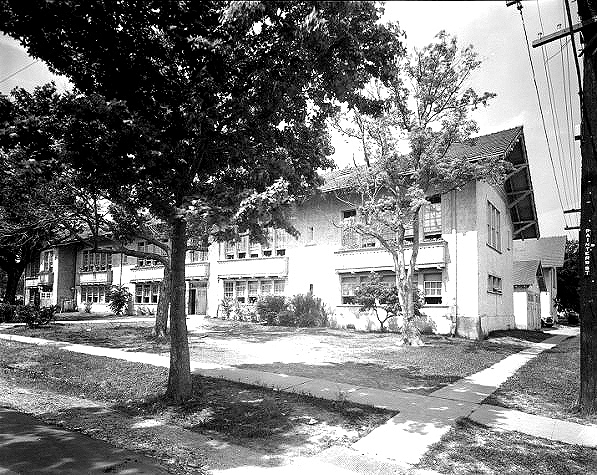
As a post World War II "Baby Boomer" growing up in the Gentilly section of New Orleans, Louisiana, I attended Gentilly Terrace Elementary School at 4720 Painters Street at the corner of Mirabeau Avenue. The school dated almost to the founding of the Gentilly area of the city, which began shortly after the creation of the Sewerage And Water Board in 1900. Pumping stations and drainage systems designed by S&WB founding engineer A. Baldwin Wood, allowed the land north and east of the French Quarter to be drained and made usable for the construction of homes and businesses.
Gentilly Terrace was a development that, by design, sat on a natural ridge formed by the overflow of Bayou Sauvage. The overflow, which had occurred for thousands of years, rendered the land higher than most below sea level terrain in the north and eastern parts of the city.
Gentilly Terrace Homes subdivision development was a business venture of three partners, city real estate manager Edward Lafaye and his partners Michael Baccich and R.E. Edgar de Montluzin. Viewable here, The land sale prospectus for the new community promised "Homes Built On Hills."
Gentilly was the second area in the city to be expanded out beyond the original French Quarter and American Sector settlements that followed the high land along the banks of the Mississippi. The extension of Canal Street toward Metairie Road, and the area known as Gentilly (mostly farm land extending beyond old Gentilly Shell Road), were the new frontiers that developed as drainage and artificial filling of the land occurred.
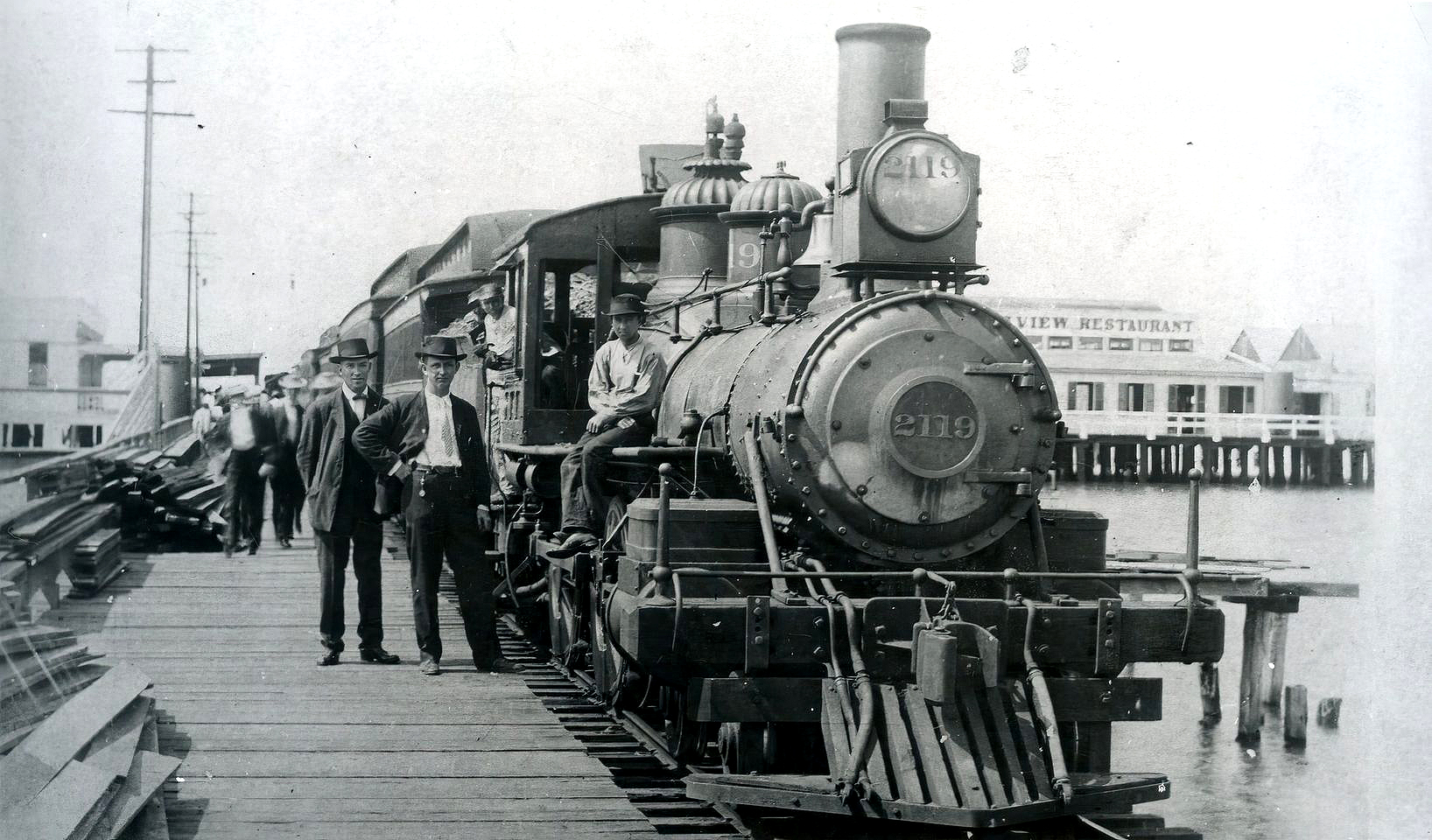
At the inception of the Gentilly Terrace Homes project, access to the area was either by way of wagon traveled dirt roads or the Pontchartrain Railroad, oldest railroad in the southern United States. The railroad operated a short line from the Mississippi River and French Quarter, to the old village of Port Pontchartrain, which also was called Milneburg. Milneburg, pronounced "millenburg" was named for the founder, plantation owner Alexander Milne who owned a large tract of land east of the original French Quarter. When this Smokey Mary locomotive photo was taken (Ca: 1904), Gentilly was comprised mostly of undeveloped land and a few family owned farms. Auto travel, in that era, was extremely difficult, as the urban part of the city ended at Florida Avenue and the L&N Railroad track. From there existed only dirt roads which were impassible by car most of the time.
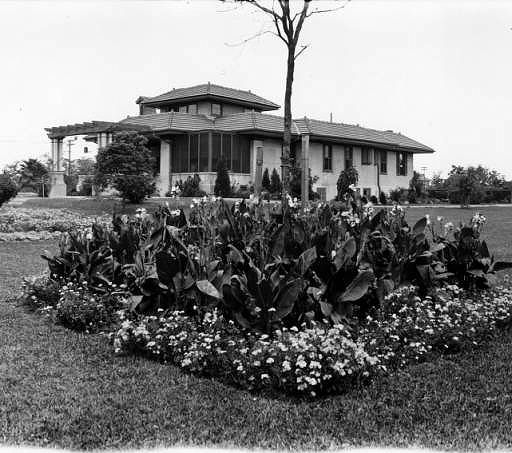
Shown here is the show place home of developer Edward Lafaye, formerly located at the corner of Gentilly Boulevard and Franklin Avenue, It was a striking example of early Gentilly Terrace residences, and intended to demonstrate the intent of the partners to create one of New Orleans most prestigious new residential housing developments. The homes along Gentilly Boulevard were mostly mansion like villas, built on the high terraces that was formed by the creation of streets. Gentilly Road existed as a walking trail, and was used by Indians from the Lake Catherine area who came to town to sell their wares at the city's Lebreton Market on Bayou Road near North Broad. The building remains today and serves as a church.
At the same time, Elysian Fields Avenue did not exist until the railroad was removed. Frenchman road, one block to the west, was the only access road leading to the farms and Jewish burial grounds that were along the railroad right-of-way. The present strip of land that became Elysian Fields Avenue in the 1930s was the road bed of the Pontchartrain Railroad, and was only developed into a roadway by the Works Progress Administratio in the mid 1930s.
THE HISTORY OF GENTILLY TERRACE SCHOOL
In order to attract upscale home buyers, desirable neighborhoods require good schools, so it was only fitting that New Orleans newest development of luxury homes needed a suitable neighborhood school. Gentilly Terrace School opened in 1914, and provided that much needed school for the children of the well-to-do families who were building their homes.
Today when New Orleanians speak of Gentilly Terrace, the designation has been applied to parts of the city which were not in the original charter. Today, the boundaries have been extended to as far as Benefit Street on the South and Paris Avenue on the West, but the actual boundaries of Lafaye's chartered development were Western Street on the West, Prentiss Avenue on the North, Peoples Avenue on the East, and Gentilly Road on the South. Obviously, the recent movement by residents and city government officials , to rename and redefine historic areas of the city in order to be eligible for state and federal money, displays their ignorance and lack of caring of history, and is distressing to historians, and confusing to true researchers.
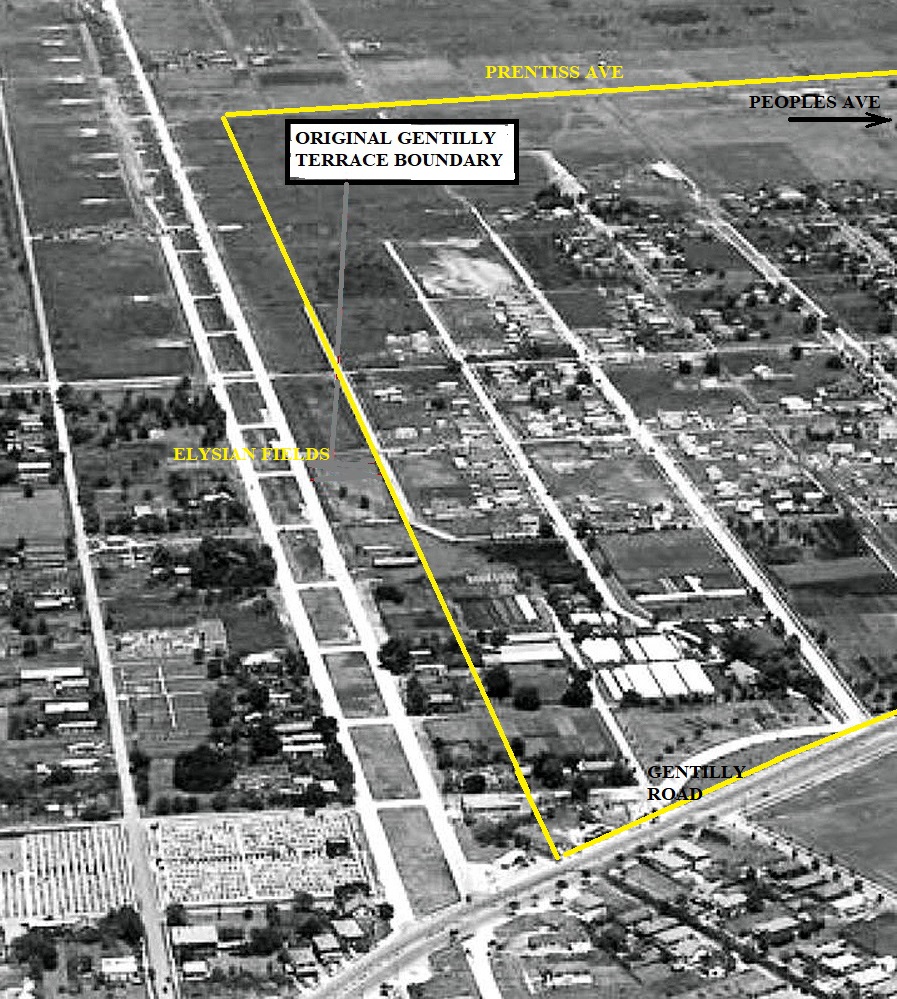
The photo at the top of the page shows the school as it looked in 1952, just prior to a major event in its hundred-year history. At the time that photo was taken, the school housed grades Kindergarten through Eighth Grade, which was the case with most of the city's elementary (or "grammar") schools. All New Orleans public schools were segregated prior to the late 1960s, and the concept of middle schools did not hit New Orleans until the early 1950s. Students who completed the eighth grade in one of the city's many elementary schools, went on to attend one of the city's four-year high schools, John McDonogh, Warren Easton, Fortier or Francis T. Nichols. For African-American students, there were separate segregated elementry and high schools. For white students who wished to pursue a trade, there were two additional high schools which offered specialty training, Rabouin which taught subjects such as practical nursing and office support to girls, and Samuel J. Peters, or "Commie High" as it was known, which taught commercial and industrial subjects to boys.
System-wide changes in the 1950s had already altered the board's operation of high schools. Previously separated boys' and girls' high schools were the rule prior to the end of World War II. McDonogh High, Warren Easton, Nicholls and Fortier, were originally segregated not only by race, but also by sex. John McDonogh High on Esplanade Avenue, which many Gentilly Terrace graduates attended, was formerly an all girls school, and Warren Easton, on Canal St. was the companion all boys school for the Gentilly and Mid City areas. The 1950s saw all of that change as high schools became 3 year co-educational programs with students attending schools based on their residential districts. A number of schools that were previously K-8 grammar schools, now became junior high schools, offering 7th - 9th grades, and the elementary schools were reduced to K-6th grade only.
At the right of the 1951 photo (top of page), we can see a former 1930s bus garage which later housed the Manual Training workshop for seventh and eighth graders. There was also a Home Economics "laboratory" in the basement of the school at the opposite corner of the building on Arts Street. Miss Clara Laticia Jackson was the school's last Home Economics teacher, and Mr. Harvey instructed seventh and eighth grade boys in carpentry and and manual training. The principal of Gentilly Terrace School at the time was Isaac Foster, who had recently been appointed to the position upon the retirement of the school's founding principal, Henrietta Keitz.
THE PHYSICAL PLANT
The School building was designed by noted New Orleans municipal architect Edgar Christy. The original design of the school was an eight classroom structure which comprised what is now the front of the present building that faces the playground and Carnot St. In 1926, the school was enlarged, and wings were added forming the present quadrangle structure. The enlarged plant included an open basement area which was used for assembly and recess congregating on bad weather days.
Until the summer of 1953, only the cafeteria, student rest rooms, three kindergarten classrooms, and the Home Economics and manual training classrooms were actually built out in the original basement. The stairwells at each of the four corners of the school, and the main "grand" staircase leading into the center of the building, were all open staircases with beautiful oak and cypress millwork, typical of early 20th Century public buildings.
On the second floor, the top of the grand staircase led to the principal's office, and an adjacent room that was used as a small auditorium.
Toilet rooms for boys and girls were located along the first floor hall in the center of the basement, just off north side of an open courtyard, with the girls' room being located closer to Arts Street and the boys' room to the right approaching the Painters Street side of the building. The "Patio," which was an open area formed and enclosed by the four wings of the building, was used as a safe play area for children in the lower grades.
Those students who attended in the 1940s and early 1950s may remember some of the earlier architectural features. For example, as mentioned above, stairways were open between floors, typical of early 1900s residential construction. They provided no fire spread protectionin within the heavily populated building. The areas under stairways were used for storage of such items as the surplus army cots that were used by napping kindergarteners, folding chairs used for meetings in the open basements, and in some cases, drums of cleaning supplies and janitorial equipment.
The idea of fire retardency was unheard of in those days, and the school's wood frame building, oak and pine floors in both the basement and second floor, and wooden interior and exterior doors fitted with with single pane glass, provided a building that could be considered a fireman's nightmare. There were no window screens with the exception of those mandated by the health department on windows in the school's cafeteria. The entire building relied on incandescent lighting with all light fixtures being the standard "school house" glass bowl fixtures which were used in many public facilities of that era. In order to provide adequate light for school activities, hundreds of incandescent light bulbs in the 150-200 watt range, illuminated the basement and classrooms, which resulted in high lighting costs for the facility.
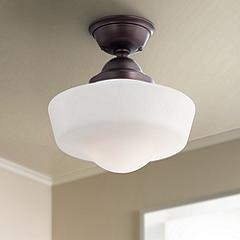
Typical 150 watt incandescent lighting fixture used throughout the GTS building prior to 1953 renovations
As far as can be determined from available records, the school had no food service facilities until approximately 1927. Prior to then, it is assumed that children eithr brought bagged lunches to school, or that some may have been allowed to go home to receive lunch. A Times Picayune newspaper article indicates that Henrietta Keitz, the school's founding principal, brought forth a pilot program wherein she was able to acquire donations of cooking equipment. With the help of parents, she was able to set up a food preparation and dining area which was then staffed daily by volunteering parents.
School provided hot meals were unheard of at the time in the city's schools, so Ms. Keitz's program was probably necessitated by the isolated location of the school, surrounded by rural working farms and mud roads. While many of the students from the families who purchased the Gentilly Terrace development homes, were of means and could afford good meals, there were a number of children from the poorer farms and original families in the area, who were probably happy to have access to a hot healthy meal during the day. It was not until the Great Depression, and the availability of Federal and State money, that the Orleans Parish School Board instituted the subsidized school lunch program across their entire system. As the Depression took its toll, for many poorer students across the system, government subsidized school lunches were the only opportunity to be provided with healthy meals.
Despite the funding of lunch programs that began in the Depression, the status of the early 1950s cafeteria at Gentilly Terrace School, was still relatively crude and mostly void of modern food preparation equipment. The room was physically located on the first floor Arts/Mirabeau corner of the building, and was accessed through wood frame screen doors similar to those found on most corner groceries and small restaurants in the city at the time. Although most of the windows in the building had no screens, screening of the food service areas had been mandated during World War -II when the nearby Agriculture Street Landfill expanded as a result of the city's growing population. Flies and other insects from the landfill became a significant sanitation problem, and health regulators mandated that windows and doors of food service areas in all restaurants and schools, be fitted with screens.
The food preparation area extended along the Mirabeau Ave. wall of the cafeteria, with a serving counter placed parallel to the wall and several feet out into the dining area. Behind the counter were open unvented gas stoves and a large exposed gas water heater, all of which took their combustion air directly from the room. Open sinks were also located along the Mirabeau Street wall, and dish washing and sanitation were were all performed by hand by the staff. Due to the absence of vent hoods, the cafeteria yielded a distinctive odor that was a combination of food stale odors and chlorine bleach.
Students dined in the same room where food was being cooked and dishes were being cleaned. Furniture consisted of long wooden tables that were painted with brown enamel paint, with seating on detached picnic-table like benches. That alone should make any sanitation-aware person take notice, since proper cleaning and sanitizing of the porous wood tables, with their scratched painted surfaces, would have been impossible. Lunch trays were dispatched from a food line, and teachers and upper grade students volunteered their lunch hours to assist kindergarten and lower grade students in getting their trays safely to the tables. Of course broken glass milk bottles and spilled food and milk were common.
To their credit, the Orleans Parish Public Schools did offer good balanced meals, Freshly prepared hot food, bread and Gold Seal milk in glass half-pint bottles, was served to students on trays with divided beige military style bakelite plates. Milk was available not only at lunch, but at recess as well for those who wished it. Food menus for the entire school system were published weekly in the local newspaper, so parents could tell what would be served to their child each day of the week.
Here is an actual example of an Orleans Parish school lunch menu from the late 1940s. The cost to students, at the time this menu was published in the Times Picayune newspaper in 1948, was only 15 cents.
| MONDAY: Hot Dogs with chili on bun, candied yams, green salad, apple sauce cake and milk |
| TUESDAY: Beans and Rice with sausage, Lettuce and tomato salad, fresh apples, dinner roll and milk |
| WEDNESDAY: Salisbury Steak with brown gravy, creamed potatoes, tossed salad, gingerbread with lemon sauce, dinner roll and milk. |
| THURSDAY: Lasagna casserole, buttered green peas, cole slaw, hot corn bread biscuits and milk |
| FRIDAY: Fried cat fish, buttered green beans, tossed green salad, bread, milk |
The cost of lunches remained fifteen cents until late in the 1950s when it increased to twenty-five cents. Prior to 1953, lunch money was collected by the classroom teachers daily, and students were issued lunch tickets for collection by the cafeteria personnel. Children who failed to provide their lunch money would usually be extended credit by Ms. Newman, the principal's secretary. In 1953, as part of the school's major renovation, the cafeteria was modernized and enlarged. As part of that project, the food preparation area was moved to a newly constructed addition that replaced the former manual training wood shop, and an enclosed ramp was constructed on the Painters St. side to allow children to line up in an orderly manner to pay for their lunches prior to being served. Lunch money was then collected by cafeteria personnel stationed at the cafeteria entrance, thereby removing that responsibility from the classroom teachers. It should be noted that in the school's most crowded years of the mid-1950s, it was not unusual for the school cafeteria to prepare and serve as many as seven hundred hot lunches each day.
POST WORLD WAR II CHANGES
By 1950, new fire codes had been adopted. Architects and safety administrators were now aware of the potential for fire spreading between open floors in multi-story wood frame buildings. Fire ratings were being placed on building materials, based mainly on research learned as a result of the recent war. Owners of publicly occupied wood frame structures were ordered to enclose stairways and raceways between floors so as to prevent or slow the spread of fire.
There was also the danger posed by the fact that a large originally coal fired boiler, absent of many safety controls that are taken for granted in modern mechanical plants, was located in the middle of the building complex. In that era, boilers in large buildings required constant attention by trained and licensed stationary engineers, and boiler explosions were not uncommon. In November of 1936, Gentilly Terrace School was heavily damaged and almost destroyed by a fire which was directly attributed to the operation of the school's hand fired coal burning heating plant.
The resulting fire damaged more than half of the building, resulted in the collapse of the roof, and forced a year long period of repair during which students were housed in area churches and willing private homes. A detailed account of the 1936 fire is provided further down this page.
With an ever growing student body in a building that literally was a fire trap, there was ample reason for the school board to undertake a major renovation project to bring this and other older school buildings up to newer fire codes established after World War II. That major upgrade for the Gentilly school occurred over the summer of 1953, as the school board was also attempting to address post-war over crowding in the city's schools. Gentilly Terrace School reopened for the 1953-54 school year as a model modern grade K-6 elementary school. The former seventh and eighth grades were moved to newly designated seventh through ninth grade junior high schools such as C.P Capdeau and McDonogh 28, previously elementary schools that were now transformed into junior high schools. .
Preceding the 1953 renovation, a number of things had transpired. In addition to the system-wide changes already discussed, there were specific changes happening at Gentilly Terrace School.
Just after Christmas holidays in 1952-53, principal Isaac Foster, who had just assumed the principalship in 1947 following the retirement of the school's original principal Miss Henrietta Keitz, died unexpectedly. Foster had taken sick during a pre-Thanksgiving student assembly, was hospitalized, and remained on leave until his death the following January. For the balance of the 1952-53 school year, Mrs. Pauline Johnson, an upper grades teacher with degrees from LSU, assumed the role of acting principal.
Prior to 1953, the GTS, like several other public schools in the Orleans Parish Public Schools System, had a custodian who lived in a house located on the property. In the case of Gentilly Terrace, that person was Mr. Vincent Danna, who, according to public records resided in a small house located on the school grounds at the corner of Mirabeau and Arts Street. In September of 1952, the school board reached a decision to eliminate on site custodial housing and require custodians to live off-site. In the spring of 1953, prior to the beginning of the Summer vacation shutdown of classes, the custodian's house was demolished. When the school reopened in the fall of 1953, the new head custodian was believed to be a Mr. Morris Allen, We have been unable to determine what actually happened to Mr. Danna, but a former student from that era, that we interviewed, thought that he may have passed away over Christmas holidays at the end of 1952.
When the school reopened for the 1953-54 school year, Clifton P. Kessler, a former coach and chemistry teacher who originally taught at Saint Aloysius High School, and who was more recently principal of Wilson public school, was appointed the new principal of Gentilly Terrace School. Kessler held that position into the 1960s, and saw to the implementation many of the school's newer concepts including an organized school band and vocal music program, audio-visual learning experiences, well publicized and successful fund raising events, competitive sports, and a well functioning parent-teachers' association and "dad's club."
As the students returned from summer vacation that year, they came into an almost unrecognizable facility. The school's stately open oak and cypress stairways had all been enclosed with fireproof gypsum sheathed walls with UL fire rated doors at the bottom of each stairway. The previous heating system had been replaced with a less dangerous gas fired circulating hot water system. Modern baseboard level hot water convectors now replaced the original unsightly ceiling hung cast iron radiators that formerly heated the first floor open basement and kindergarten rooms. The updated heating system, removal of wood floors at the first floor level, and installation of modern lighting allowed the construction of eight new classrooms in the former open basement areas.
The principal's office had also been modernized and expanded into a suite of offices on the second floor opposite the grand staircase. The small assembly room, immediately to the Painters street side of the original office, now became part of the expanded principal's suite. With that change, a new modern auditorium, capable of seating a large segment of the student body at one time, had been constructed in what was previously the open patio that was surrounded on all sides by the original school and the 1926 building additions.
The 1920s wooden bus garage, that later served as the "manual training" workshop, had been demolished and replaced by a new cafeteria kitchen with modern food service equipment, sanitary restaurant style tables and chairs, and a stainless steel serving lime where students were served their food in true cafeteria style. Although the cafeteria renovation was not completed until several weeks into the Fall 1953-54 session, it was considered a dramatic improvement from the primitive facilities that it replaced.
The former Home-Ec lab, which was located on the Arts Street right hand corner, had been turned into a fourth kindergarten classroom, anticipating the expanding student body that resulted from post-war Gentilly development. A state-of-the-art fire alarm system, an IBM automatic clock and /bell ringing system, and an all classroom public address system had all been installed, making it possible for students to remain in their classrooms for the daily announcements that previously required classes to line up in the open basement each morning.
From the operations side, a safer gas fired hot water boiler and heating system had replaced the building's original manually operated heating system. Much of the maintenance staff could now be freed up to perform other duties, and the daytime staff was reduced to one operating engineer/janitor, and a janitor assistant. Cleaning was also performed after-hours by a separate staff of custodians, which allowed the two daytime custodians to concentrate on operation of the heating system and maintenance of the building's other systems.
THE ANNEX
Those of us who attended Gentilly Terrace School in the 50s will surely remember the "Annex" which was located on the opposite end of the school grounds facing Carnot Street. It was a wood frame building, reminiscent of a military style barracks buildings typical of temporary construction through much of World War - II. The annex housed the school's fifth-grade classes, as well as an overflow third grade class. The annex had been constructed during the 1946-47 school year as a means of easing the over-crowding that resulted from a dramatic population increase in the Gentilly and Lakefront areas due mainly to the expanding post-war development of Gentilly. With the 1953 main building renovation, little was done to the Annex, and updates were mostly limited to installation of a fire alarm system. This reflected the view of the school board that the non-code compliant structure was merely intended to be a stop-gap measure to buy the board some time to complete construction of new schools in Oak Park, Lakeview and Gentilly Woods. The annex was literally a wood frame, wood floored fire trap, heated by individual gas fired space heaters installed in each classroom. It was lighted by antiquated incandescent light fixtures, and most furniture consisted of well worn 1920s attached pedestal student desks which apparently had been used elsewhere before they were incorporated into the 1946 project. Students assigned to the annex were forced to use unheated outdoor toilet rooms and water fountains that remained until the building's demolition many years later. Demolition occurred in the 1970s, at which time overcrowding had been reduced, to the point that all classes could again be housed in the main school building.
Please note that we are attempting to locate usable photos of the exterior of the Annex. If anyone happens to have photos showing the interior and exterior details of the Annex, please allow us to share them through this site.
It should be noted that the 1950s Post War era was the greatest period of residential development in the Gentilly and Lakefront areas of the city. The Great Depression and then World War II had delayed the eventual growth of the Gentilly Terrace neighborhood. It was only due to a heavy presence of military facilities along the lakeshore, that war-time housing construction on the undeveloped land between Gentilly Road and the lakefront, began the residential population explosion of the area, and thereby increased the student population of the area's only public school.
Following the War, exponential development and growth in not only the Gentilly and Lakefront area, but also the development and inclusion of most of New Orleans East into the service area handled by Gentilly Terrace School, literally strained the walls of the old facility that was only designed to handle the children of the one square mile area of the original Gentilly Terrace subdivision. With much of Gentilly's undeveloped area turned into housing for employees of the factories and military installations along the reclaimed lakefront, and later the families of returning military personnel, the population of Gentilly exploded in the late 40s and early 50s.
By the start of the 1953-54 term, the school, which originally was staffed by one principal and two teachers, had grown to a minimum of four classes for each for the six elementary grades and kindergarten. There were five fifth-grade classes at the time that most of the post WW-II baby boom children were at that level in their education, and classes generally housed between 30 and 40 students under the management of a single teacher. A number of those teachers at that time were still Normal School trained, and did not possess college degrees. Many were in the process of obtaining degrees, however there were teachers who retired in and after the 1950s who were still operating on their Normal School training and certificates. Later, as new public schools were constructed in the Gentilly, Lakeshore and New Orleans East areas, the student load on Gentilly Terrace School was reduced. The removal of the seventh and eighth grades in 1953 also served to reduce the population serviced by this school, so it then became possible to modify the student-teacher ratios, and to seriously contemplate demolition of the Annex. Still, however, the school remained crowded, well beyond its initial eight classroom design, with an average enrollment approaching eight hundred students through much of the 1950s.
The following are photos from private collections, and from various state and public library collections, that are presented as an historical perspective of what life for a student in Gentilly Terrace School was like in the 1950s. We appreciate the use of photographs held by persons who posted to social media sites, and we have attempted to give photo credit wherever possible. We have also provided a list of the faculty from the 1950s, and have indicated their present status. whether alive or deceased. If anyone who views this site has additional information that would be of interest, we will be happy to incorporate it into the site. Thanks especially to those folks on the "I grew up in Gentilly" and "people who attended GTS in the 50s" Facebook sites for making available several photos and many memories of our old school and life in Gentilly in the 1950s.
GENTILLY TERRACE SCHOOL BUILDING
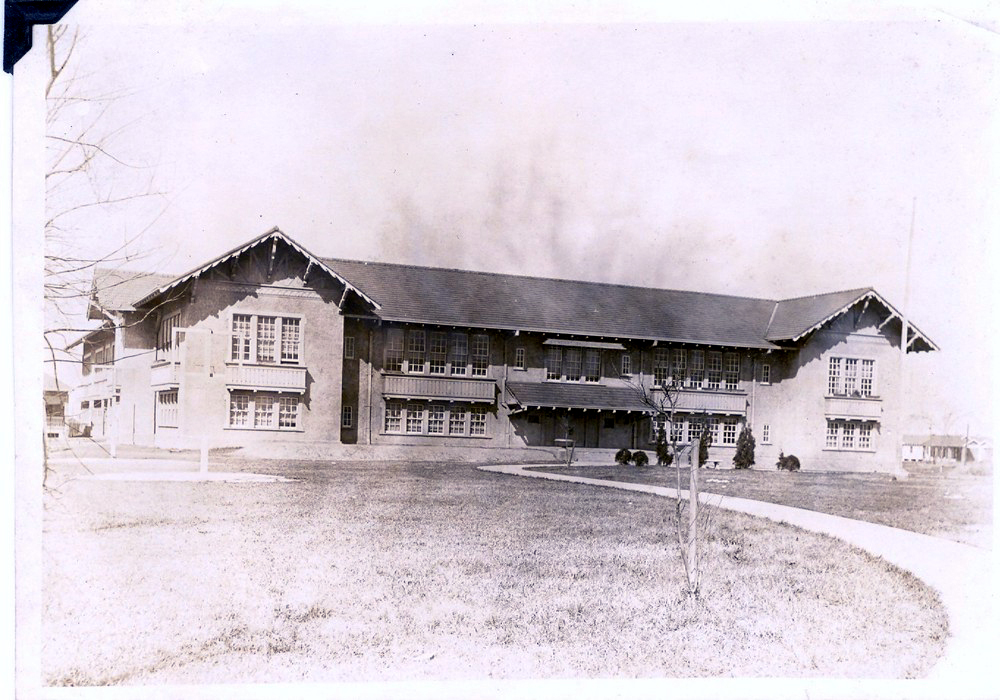
Above is a photo of the school building, believed to date to 1926-27, as it looked following the 1926 addition of the east and west wings that extend back toward Mirabeau Avenue. Noteworthy are the second story window flower boxes that provided students with a place to grow plants as part of their studies, and which also protected against accidental falls from the large unscreened casement windows that were fully opened in warm weather. The building relied on open windows, high ceilings and transoms for air circulation in the early and late weeks of the school year. Portable fans only came on the scene in the late-1950s when PTA fund raisers made the purchases possible, and window air conditioners were only added well after the 1950s.
Notice that the boiler chimney, which towered above the roof when most us us attended GT in the 1950s and later, and which is clearly visible in the 1956 photo below, and the pre-Katrina photo at the bottom of this page, does not yet exist in the 1926 photo above. The suspected cause of the great 1936 fire was reportedly a defect in the original boiler chimney, so evidence supports that the original chimney probably terminated too close to the wood and tile roof, and that the chimney was necessarily replaced or extended as a full masonry chimney well above the roof line, during the 1936 fire repair contract work.
One additional note, just inside the border at the middle left of the photo above, the live-in custodian's shack is still visible. As stated previously, it was demolished just prior to the 1953 renovation. The New Orleans City Directory from that year indicates that the resident of 4764 Arts Street, which would have been the address assigned to the custodian's house, was Mr. Vincent Danna, who is further listed as a school custodian. We therefore believe that the last live-in janitor for the school was in fact Mr. Danna. If anyone has further information on this, please let us share it through this site.
Photo above is courtesy of the LOUIS digital library-State of Louisiana. Photo below is from a 1956 school publication provided by Mrs. Joy M. Hopkins (Class of 58).
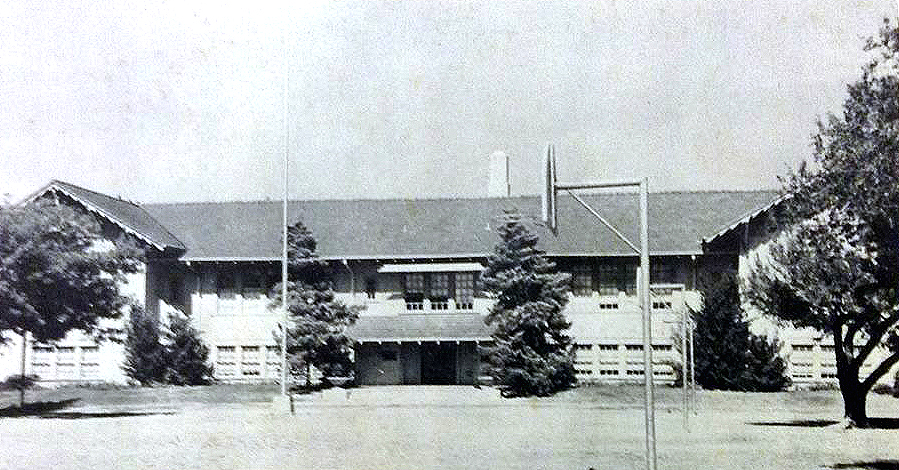
In the course of the researching the school's history, we discovered that the original school building, completed in 1914, was only the front section of the present school structure that is pictured above. In several Times-Picayune articles going back as far as the 1914 construction and dedication, the school was referred to as an eight classroom wood frame structure. Later articles indicate that two wings, east and west, were added around 1926. Each of the two wings added in 1926, contained four classrooms each on the upper floor, and an open basement on the lower floors. A lunch room was also included on the lower floor of the Arts/Mirabeau corner of the expanded building. Although we can find no supporting documentation, the portion along Mirabeau Avenue, which contains the student rest rooms and portion of the cafeteria food preparation area, were probably added at that same time, thereby forming a quadrangle around what became and enclosed patio yard at the core of the structure.
To see a copy of the 1926 Times Picayune article about the building expansion and wing addition, click here
FROM ITS 1914 FOUNDING.
By the 1919-1920 school year, Gentilly Terrace School had already become a fixture as families began to build houses on the lots that the new development offered. While the school began in 1914 with only Miss Keitz as the principal, and two other teachers, the 1919-1920 roster of Orleans Parish School Board employees listed the following ten teachers and employees assigned to Gentilly Terrace School:
GENTILLY TERRACE— Boys and Girls.
Grammar and Primary.
District: Neighborhood.
Miss Henrietta C. Keitz Principal
Miss Fannie Tobin Assistant
Miss Claire Leefe Assistant
Miss Hermia Feraon Assistant
Miss Marion' Wadsworth Assistant
Miss Marion Phillips Assistant
Miss Amelia Masson Assistant
Miss Rita Sbisa Assistant
Miss May C. Nobles Kindergarten
Mrs. Clemence Raby Janitor
Note that no food service employees were listed in the 1919-1920 roster. As mentioned on this site, the lunch room did not exist prior to 1927, and only then as a facility staffed by parent volunteers.
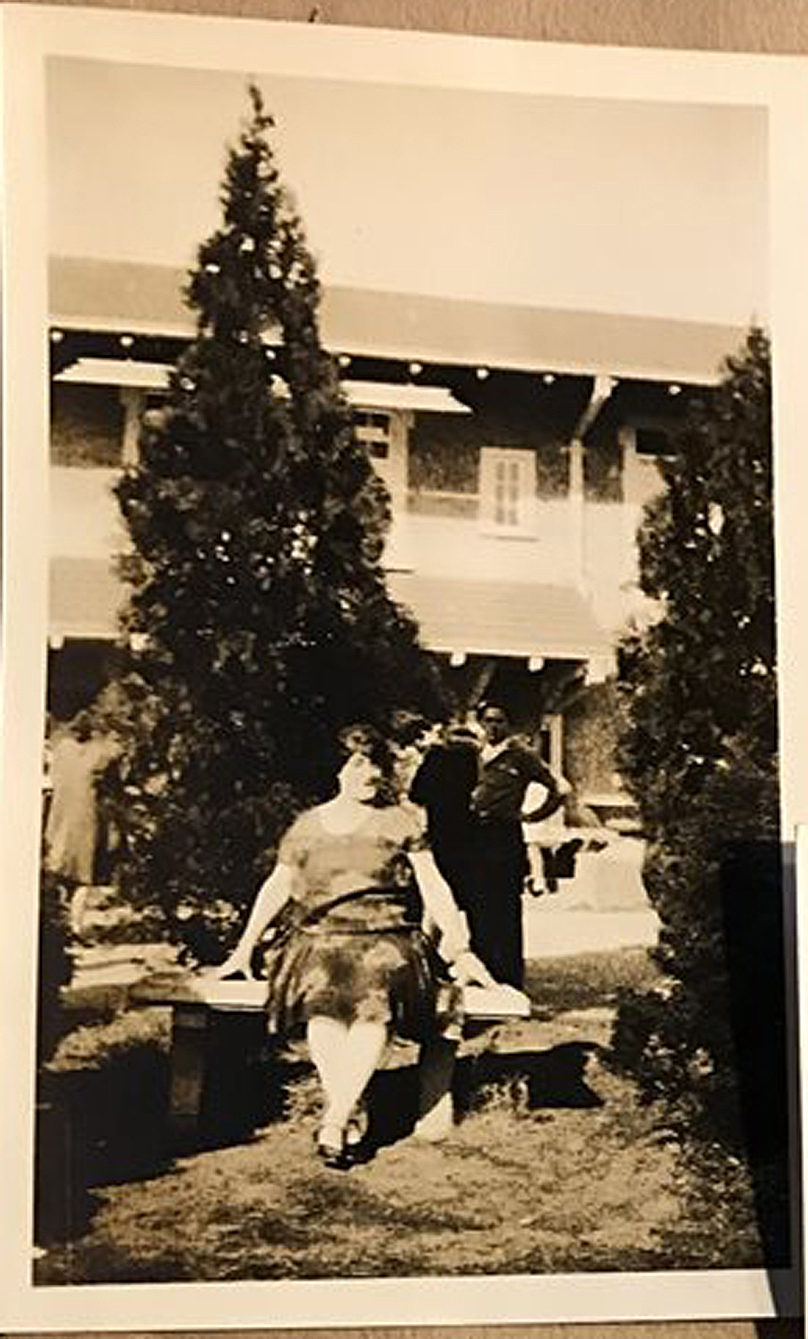
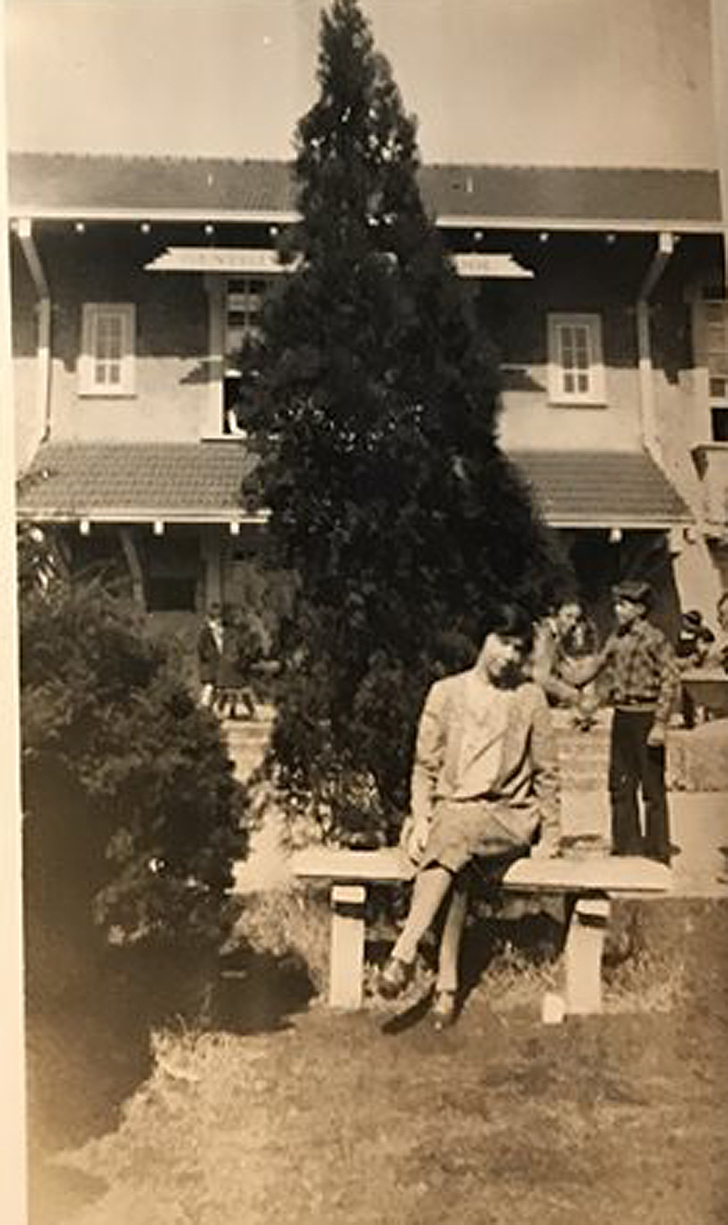
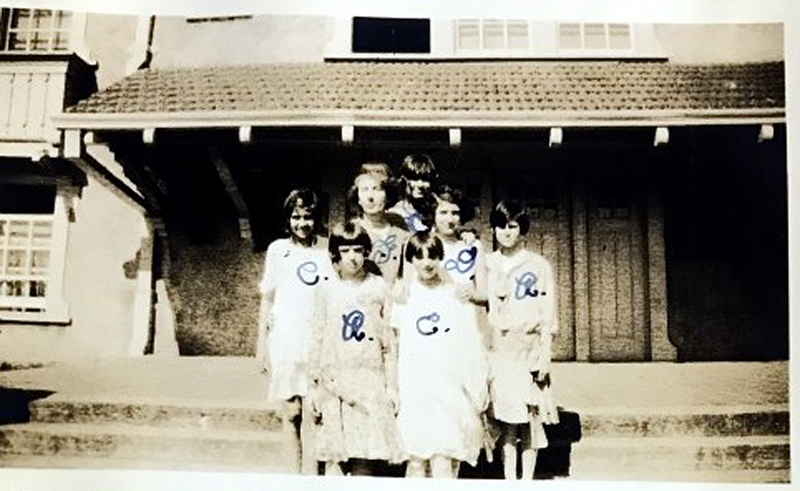
Shown here are a group of Gentilly Terrace School teachers and students from the 1930s era. They are identified as follows:
Miss Tobin in center of second row
Miss Louise Siedlock in back of Miss Tobin
Students shown are: (front row l-r) Estelle Mire and Ruby Jacobson
(second row) Caroline Muniz, Polly Zinzer, and Ruth Saunders.
Many of the GTS teachers spent most or all of their teaching careers at the school. Ms. Keitz was principal from the school's opening in 1914 until her 1947 retirement. Her connection as a former instructor in the Normal School, allowed her to hand pick the best of the Normal School graduates to teach at Gentilly Terrace. The article below confirms that career teachers Clara Mascara and Alma Flucke, both Normal School graduates who trained under Ms. Keitz, were teaching at the school as early as the late 1930s. Although Ms Keitz retired in 1947, Ms. Flucke and Ms. Mascara, and a number of other Normal School trained teachers, remained at the school through the 1950s and into the 1960s.
GENTILLY TERRACE SCHOOL TEACHERS INJURED IN AUTO ACCIDENT:
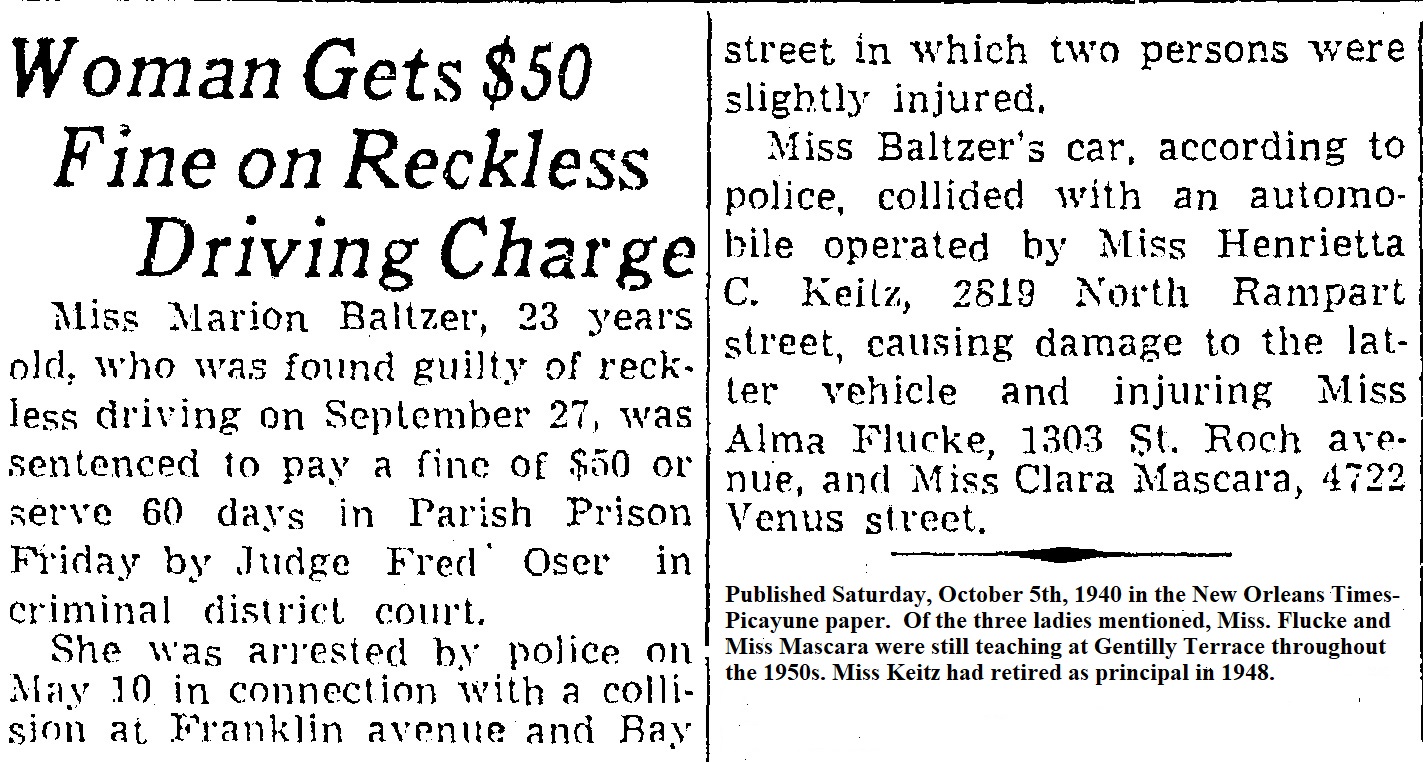
THE 1936 FIRE
As previously reported above, the building was involved in a major fire that occurred in November of 1936. In the newspaper account of that fire, there was again a reference to the original 1914 school structure as having been comprised of only an eight room wood frame structure. The 1936 articles, however, indicate that the building involved in the fire, was already built out to approximately the present quadrangle configuration. At the time, Gentilly had no presence from the New Orleans Fire Department in the way of a fire station or engine company. In the event of fire, engine companies had to come from the closest fire house at Elysian Fields and North Robertson Streets, and fire fighters were often delayed to their destination by slow moving trains on the L&N and main line tracks that both intersected Elysian Fields Avenue. The experience of the Gentlly Terrace School fire, and resulting pressure on the city by residents of the area, was a major determining factor in bringing about the construction of the fire station which existed for years on the corner of Elysian Fields and Foy Streets.
A summary of a Times Picayune indicates that on the morning of the fire, which happened to be the first really cold day of the school year, the "Negro fireman" had stoked the boiler with 75 shovels of coal, starting at 5:45 AM. Miss Keitz discovered the fire as she was making her rounds of the halls shortly after classes had begun for the day. The cause of the fire was attributed to the chimney of the school's heating boiler, which set the roof on fire. Upon discovering the blaze, Miss Keitz sounded the fire alarm with her brass hand bell, and then proceeded to go to the office to retrieve the money that had been collected for the Community Chest, along with an historic statue that stood at the entrance to her office.
Shortly after the children were out of the building, which occurred in a record sixty-seconds thanks to Miss Keitz's regular fire drill practices, the roof of the building collapsed. Repairs took the remainder of the school year, and classes were held in nearby churches, homes and establishments that offered space to assist the school.
To see a copy of the November 1936 fire article, click here:
__________
Apparently some time between the occurrence of that fire, and the early 1950s, the school's boiler had been converted to burn natural gas instead of coal. By 1951, natural gas service for the boiler was evident, as seen in the pre-renovation photo at the top of this page, and in the enlarged segment of that photo below, by the presence of a large gas meter just to the side of the Painters Street entrance. There was also a large above ground oil storage tank in the yard outside of the boiler room, which may have been an indication that oil was also used as boiler fuel some time between the 1936 fire and the installation of gas service to the area. Following the 1953 renovation, natural gas was definitely deployed as the boiler fuel for heating, and the entire building was utilizing circulating hot water in order to accommodate safer baseboard convectors used in newly constructed first floor classrooms and assembly areas.
Some students may remember those talks, that many of the veteran teachers gave us during Fire Prevention Month about the importance of fire drill preparation in our school. , The memories were still vivid, for some of the teachers who were there. of the severity of the 1936 fire, and the ever present potential for fires and boiler explosions in the wood frame building. It was only due to Miss Keitz's well practiced fire drill procedures, that students were able to be evacuated safely from the building as the 1936 fire threatened to collapse the roof. We were therefore regularly cautioned, by our teachers and the principal, to take all fire drills seriously.
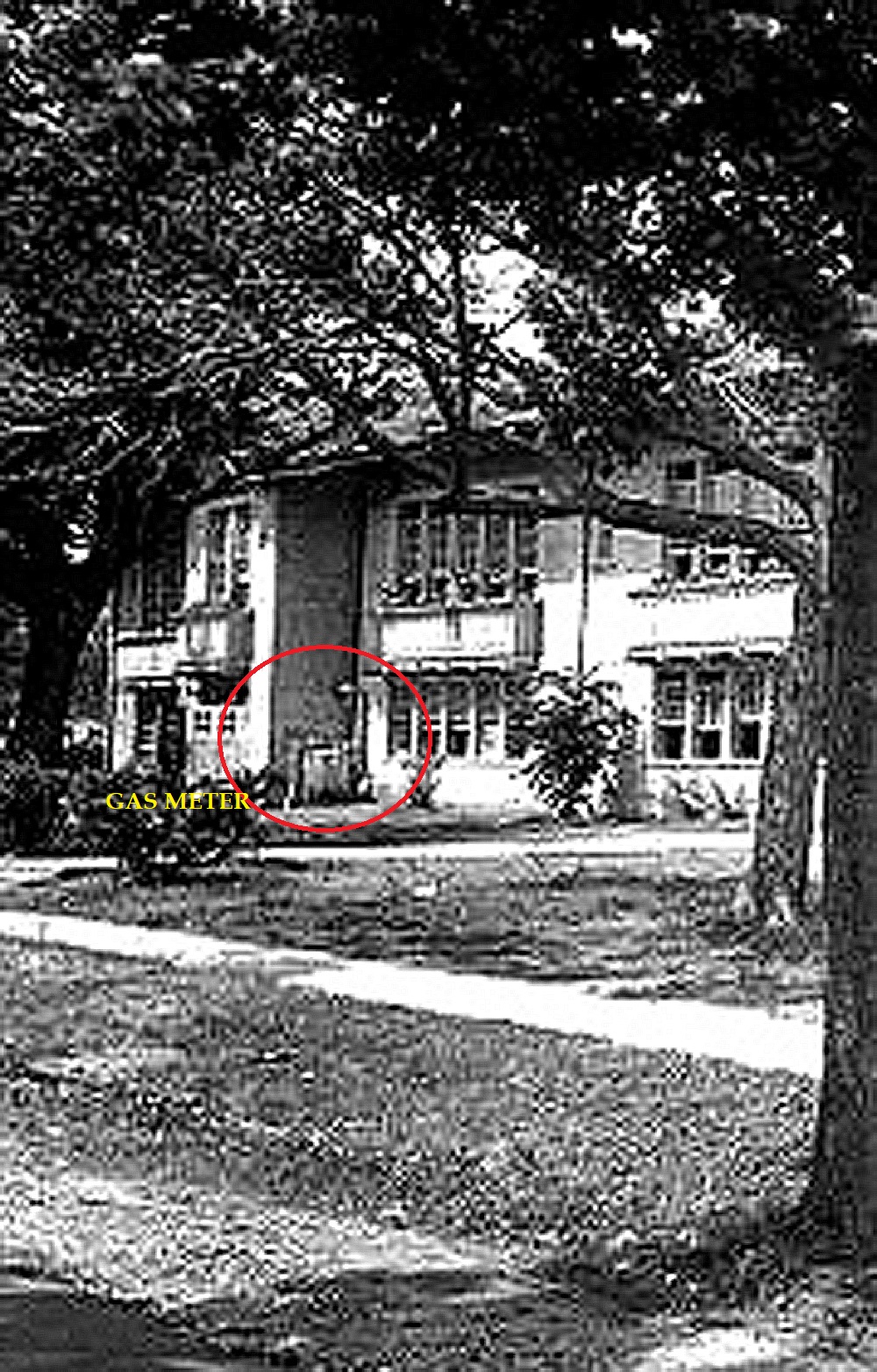
The boiler that was in use in the 1950s, from this writer's recollection, was a large cast iron sectional similar in design to the boiler in the following photo.
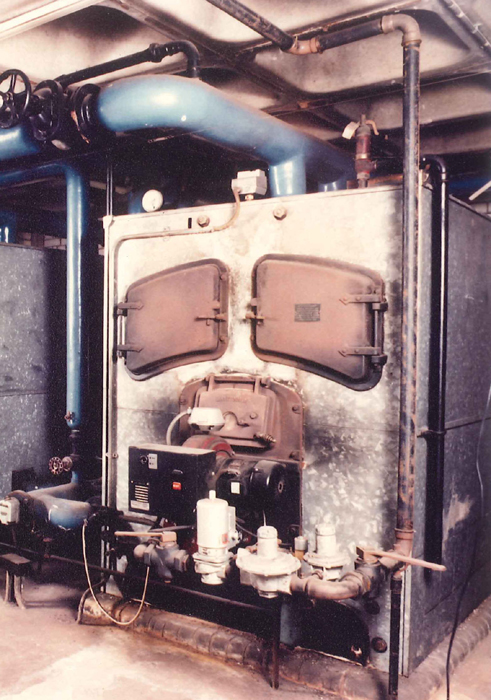
There were open windows from the patio to the boiler room, prior to the 1953 closure of the yard in order to construct the auditorium, and I looked in those windows many times as a kinerfartener and first grader. My later discussions with boiler maker Bert Leaveau, confirmed that the boiler was probably replaced during the summer 1953 renovation. Not having blue prints available, or anyone still around who was aware of the mechanical situation in that era, I have not been able to determine if the system had been steam at some point, or if it always operated as a circulating hot water plant. Photos of ceiling mounted radiators, as shown in the boy scout assembly photo from the late 1940s, seems to show steam traps. Also, mounting the radiators on the ceiling would be consistent with being able to return condensate back to the boiler room. When the basement classrooms were added in 1953, and baseboard convectors were installed throughout the first floor, it is fairly certain that hot water was the heating medium at least for the first floor. If anyone has knowledge of whether there was a steam to hydronic conversion, please let me know. Presently, the system is definitely circulating hot water. In 2004, I visited the boiler room, and there was a newer single 10 million BTU cast iron sectional boiler heating the entire building. In the photos below, apparently that boiler was replaced with two smaller thermo-pak style boilers after Katrina, however these too are hot water boilers.
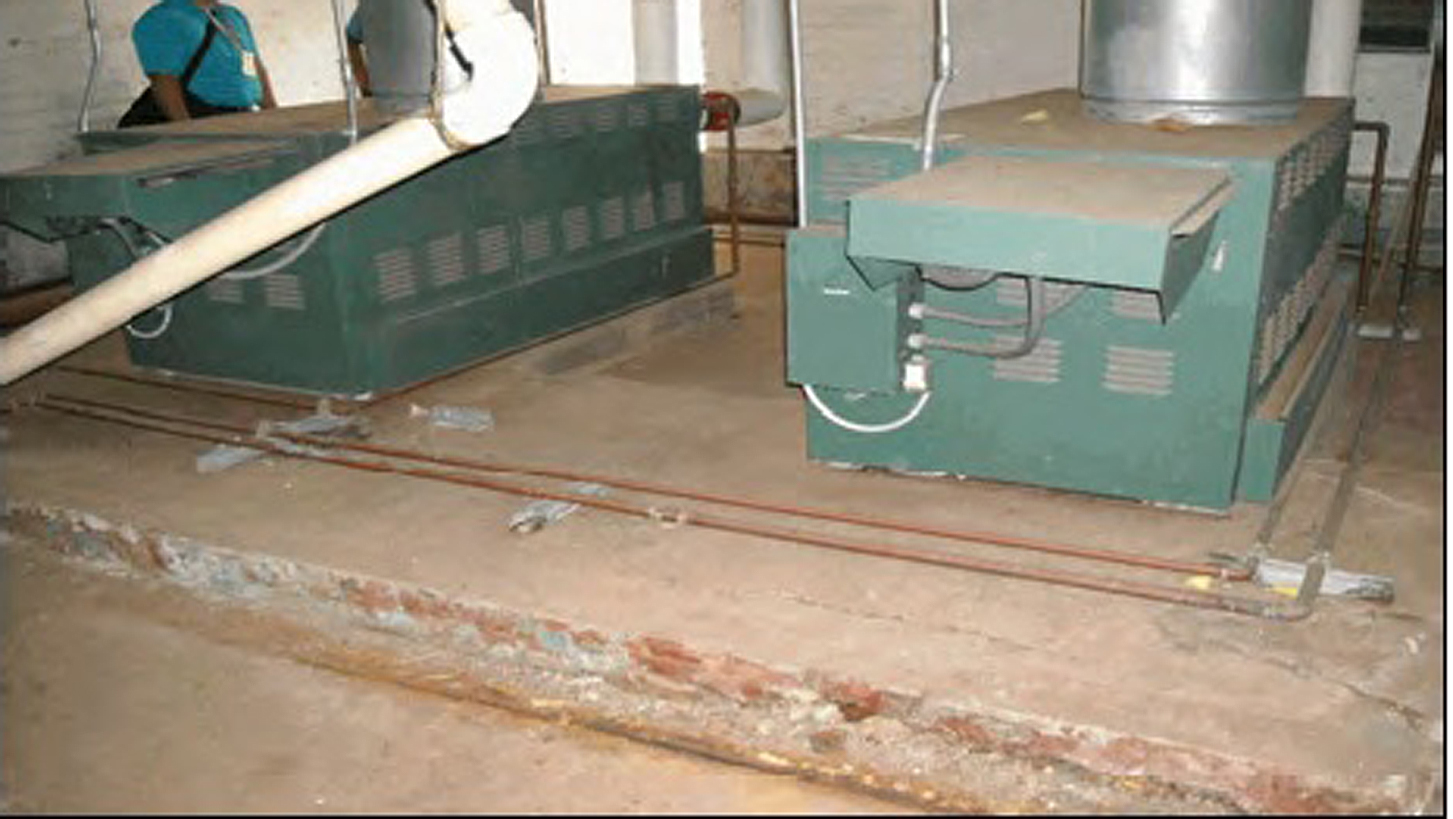
Unfortunately, from what I have learned, all documents and blueprints pertaining to the school were lost in the flood of a warehouse on Almonaster Avenue during Katrina. If anyone has info pertaining to the physical plant, and it's evolution over the school's history, we would welcome this information to complete the record on the architectural and engineering specifics.
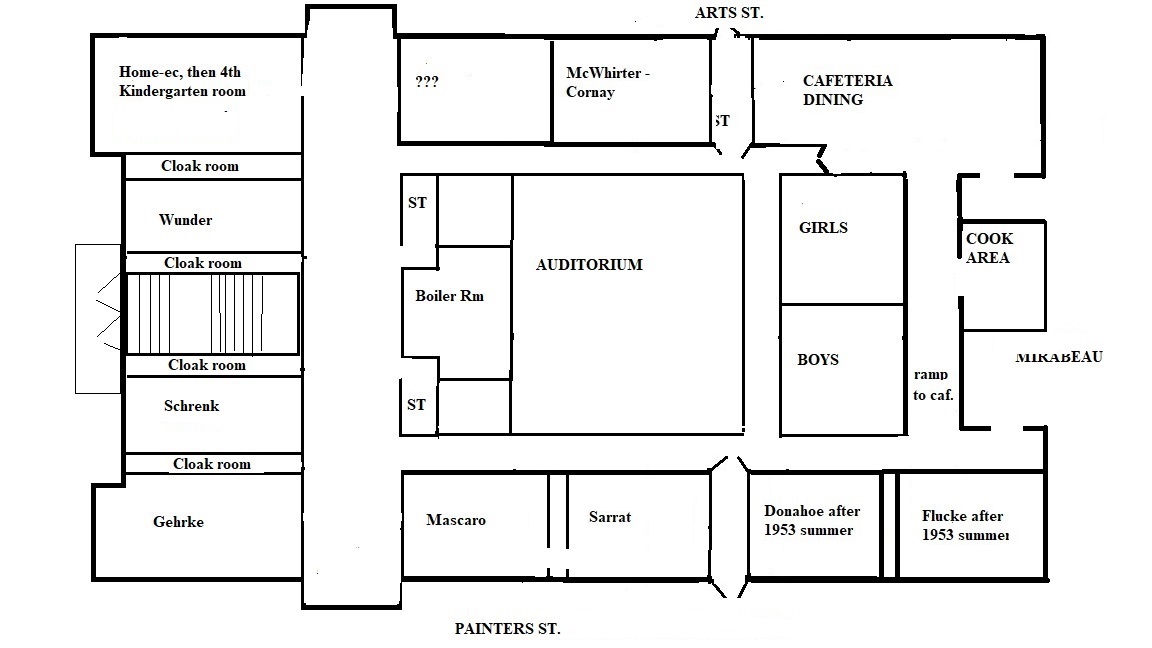
Note that prior to the 1953 renovation project, only the four classrooms at the left existed. The remainder of the classrooms shown, were built out in in 1953 in what was previously open basement area.
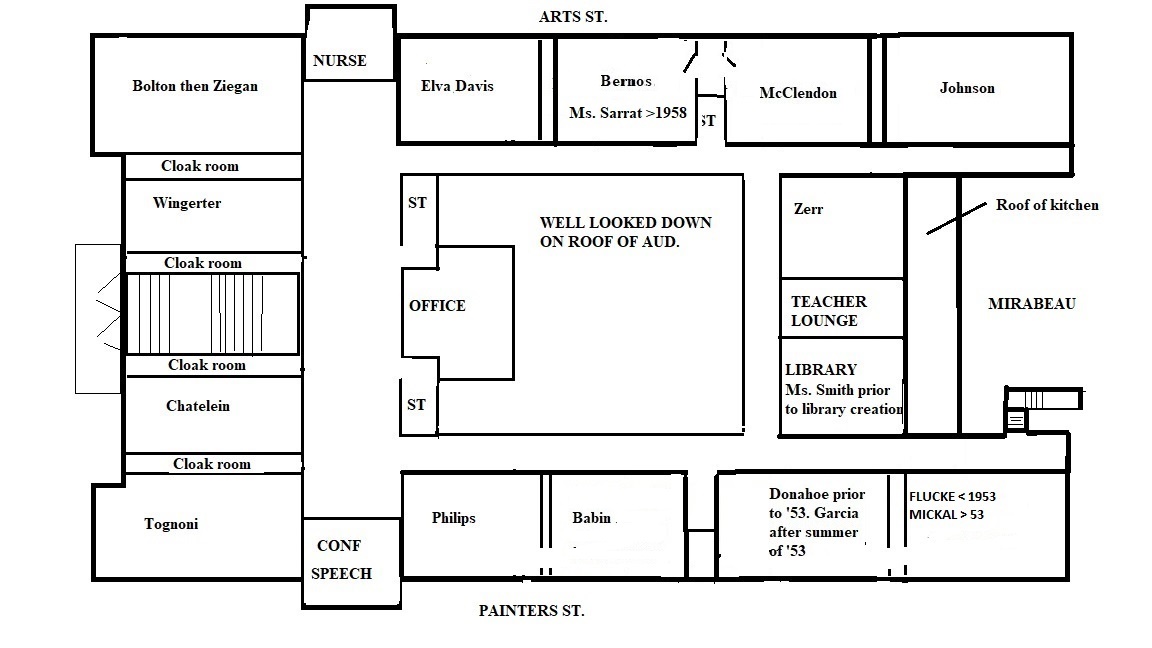
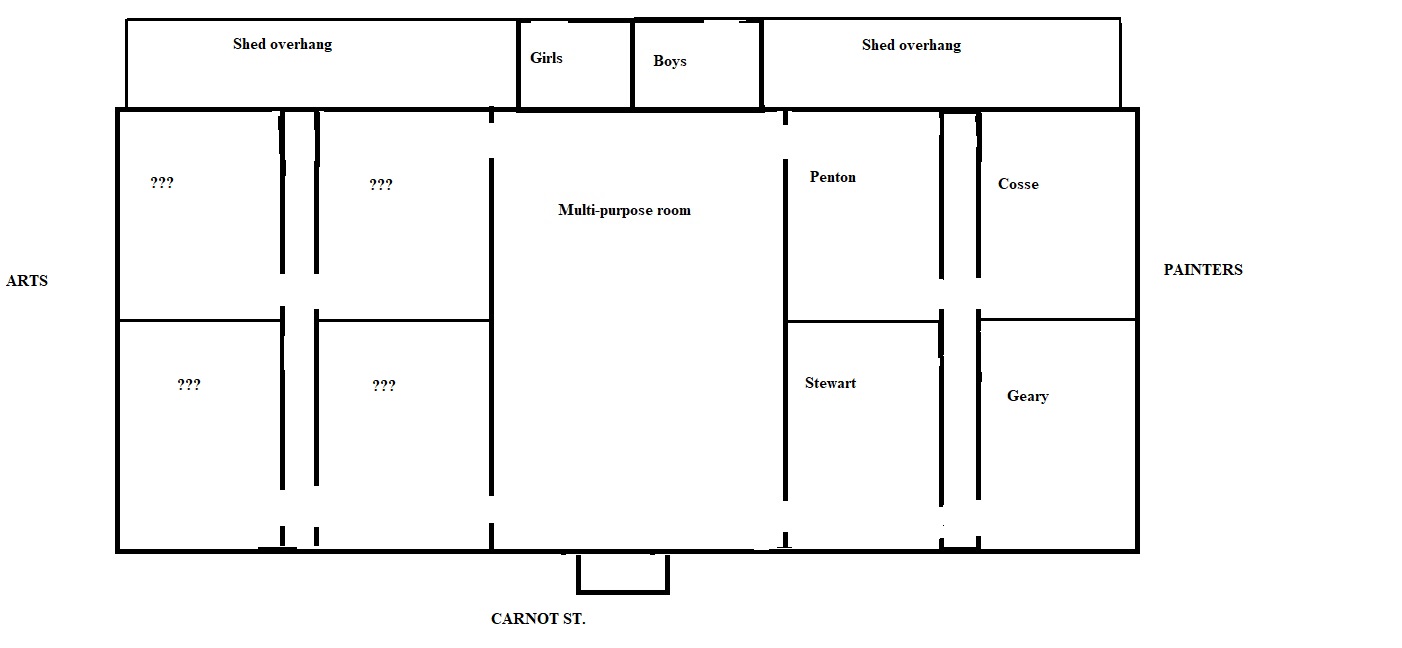
CLASSROOM PHOTOS
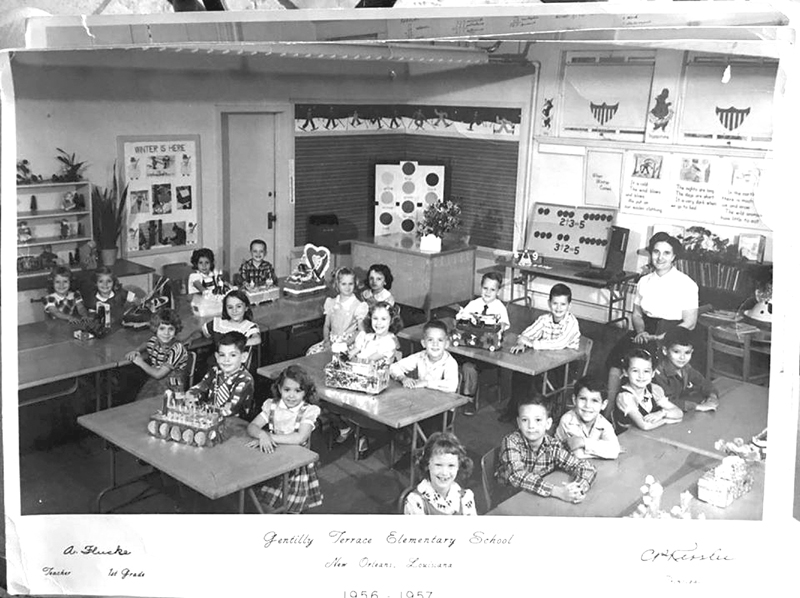
On several students' tables, parade floats made from shoe boxes, are visible. Assigning the building models of Mardi-Gras floats from shoe boxes, apparently was a favorite home work exercise to be issued by the Normal School trained teachers. It is therefore evident that this photo was taken some time in the days preceeding the Mardi Gras holiday in New Orleans.
(photo courtesy of Barbara Stempel Smyth)
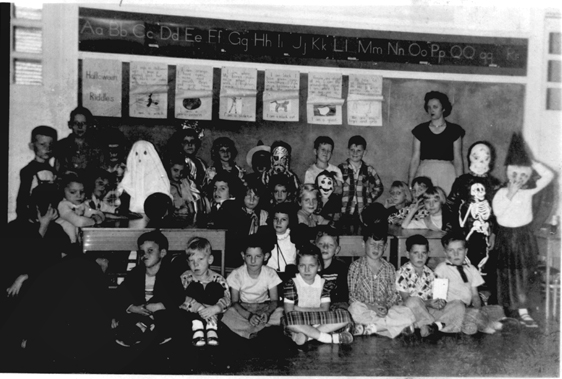
(Photo above by seven year old John DeMajo)
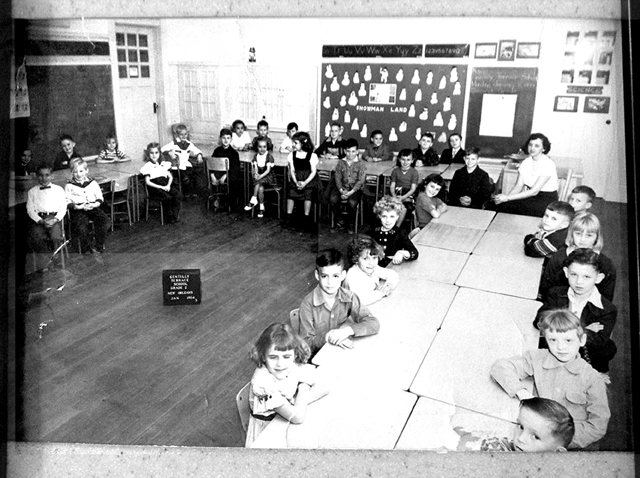
(Photo above courtesy of Joy M. Hopkins)
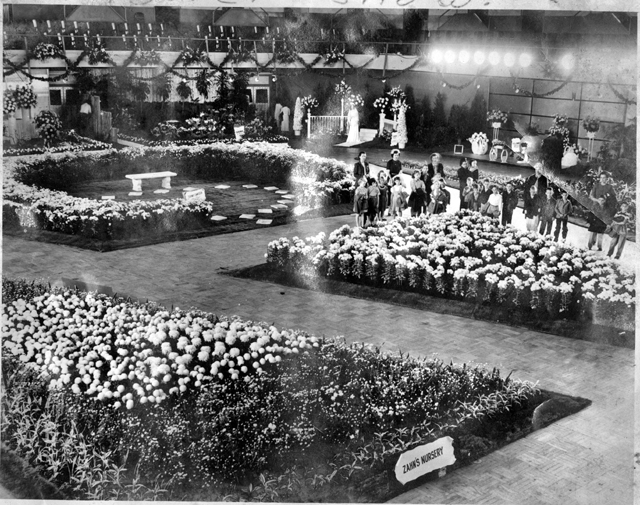
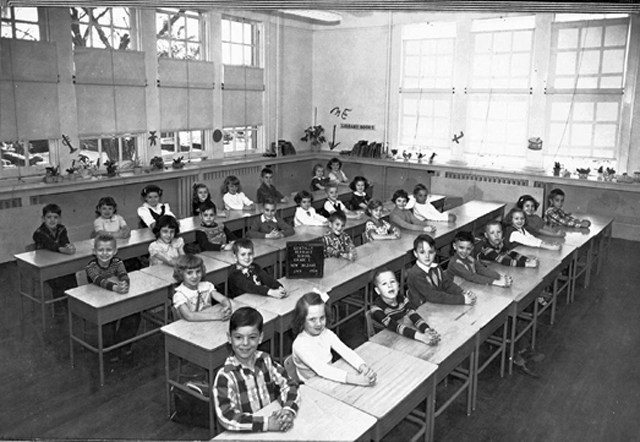
(Photo courtesy of Kay Scudder Gill)
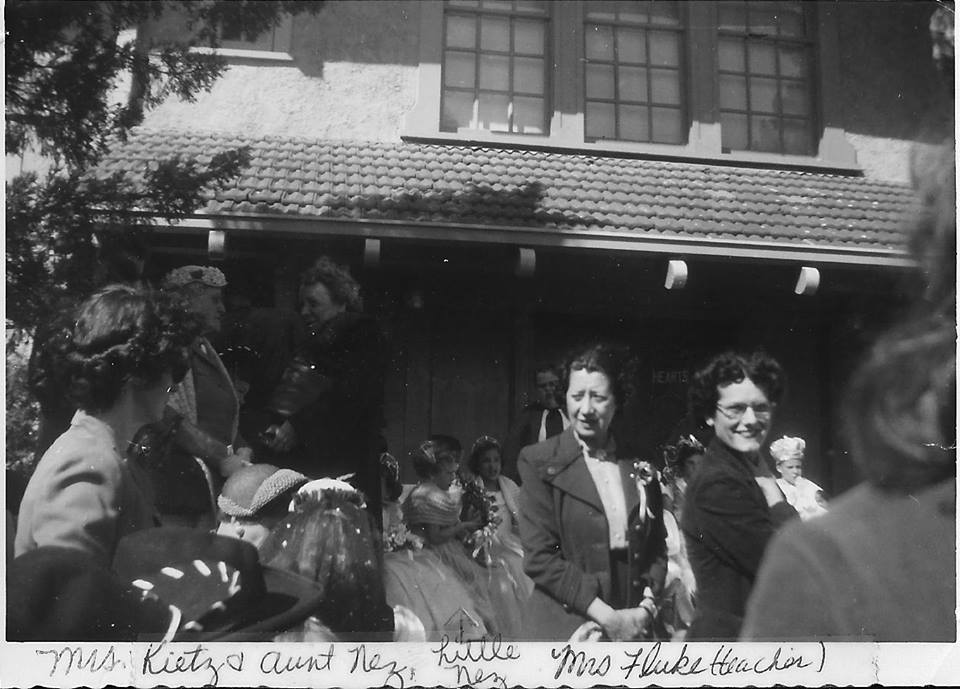
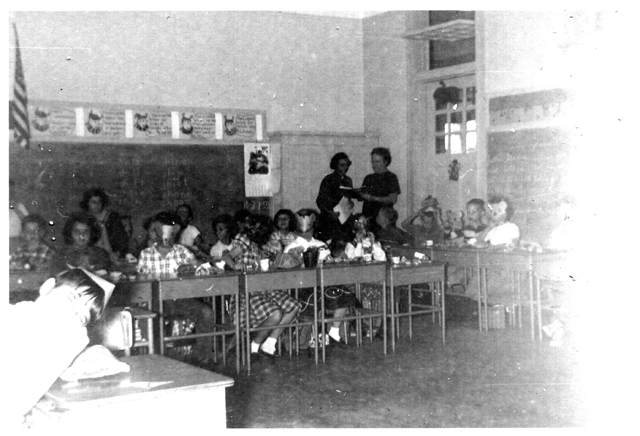
(Photo above by John DeMajo)
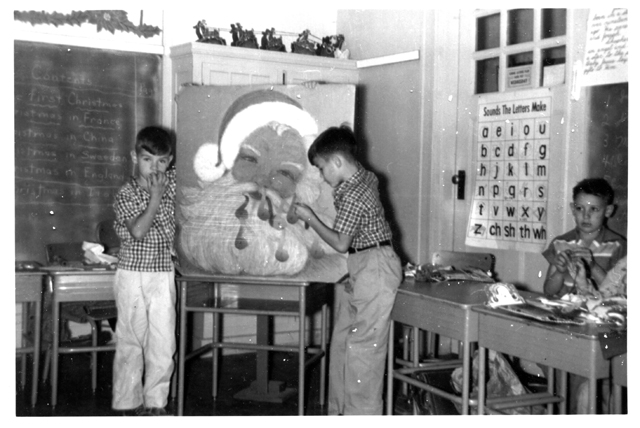
(Photo above by John DeMajo)
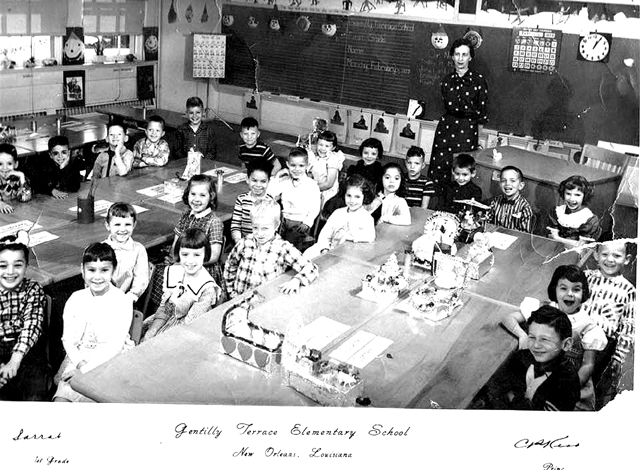
Above: The first grade class of Miss Marian Sarrat
Miss Sarrat's classroom here is typical of the new first floor classrooms that were created during the school's 1953 summer renovation. In the photo below, Miss Sarrat had been promoted to teaching 4th grade by the end of the 1950s. She moved from her classroom on the Arts street side of the basement, and assumed the second floor classroom previously occupied by the 4th grade classes of Miss Betty Bernos.
(Photo above courtesy of Stephen Elmer and photo below courtesy of Barbara Stempl Smyth)
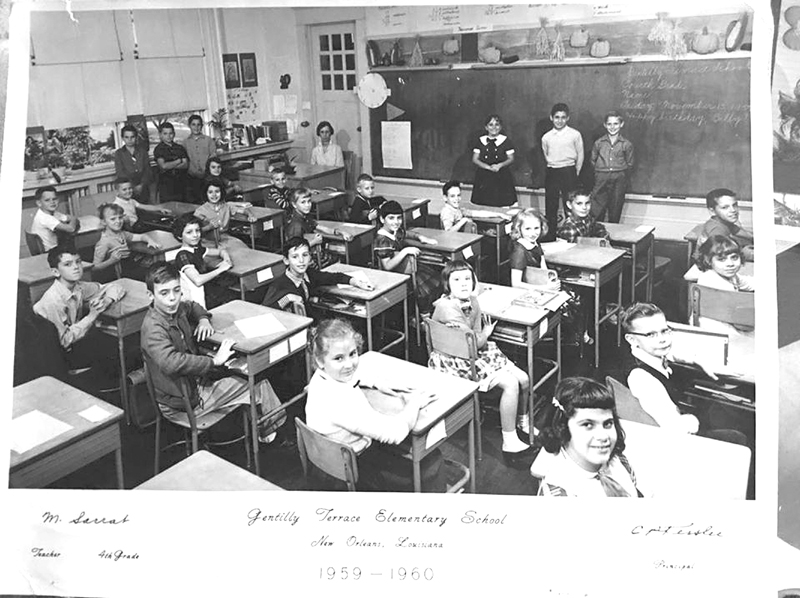
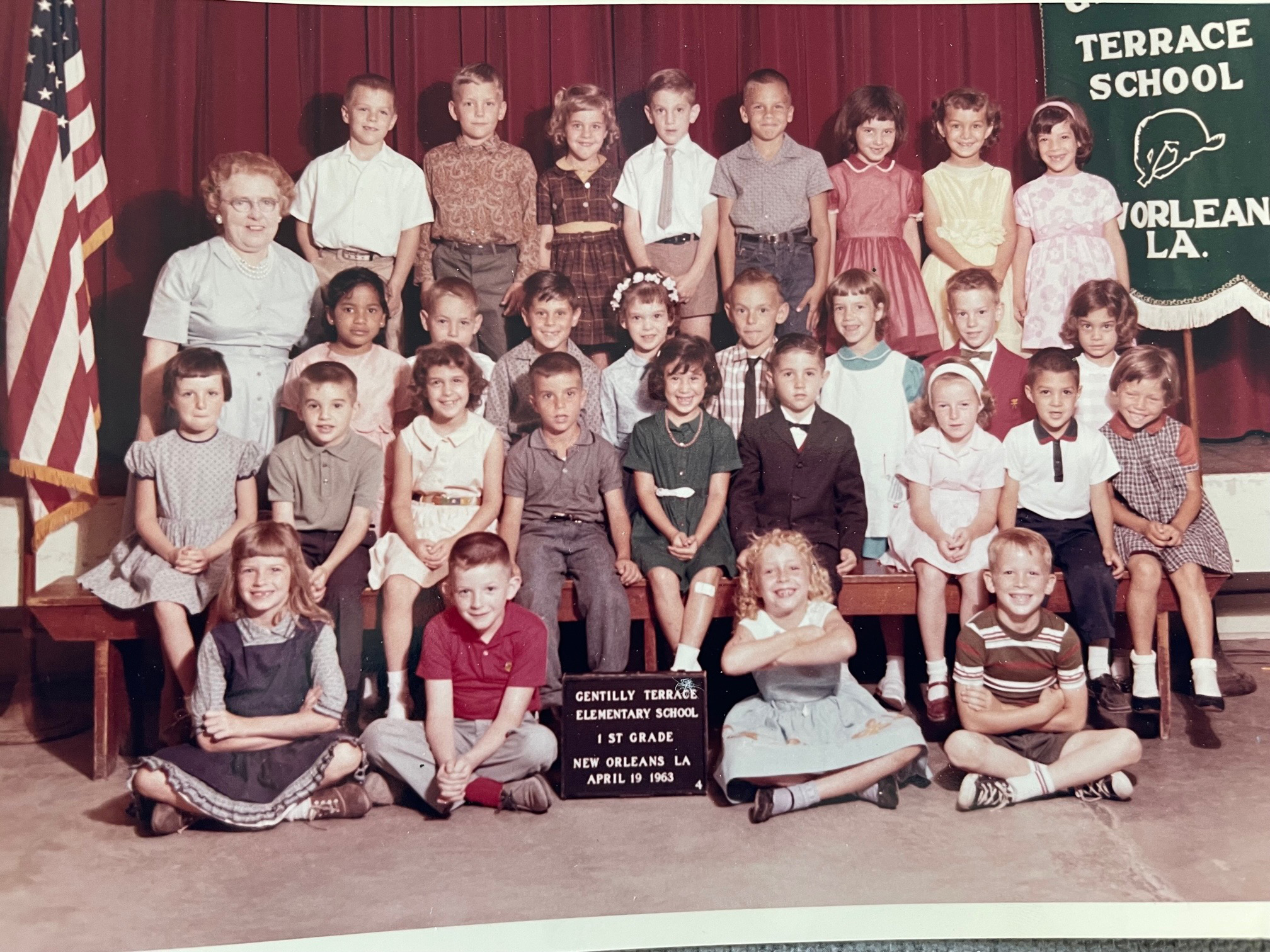
This photo and photo below are courtesy of Randy Rosenburg
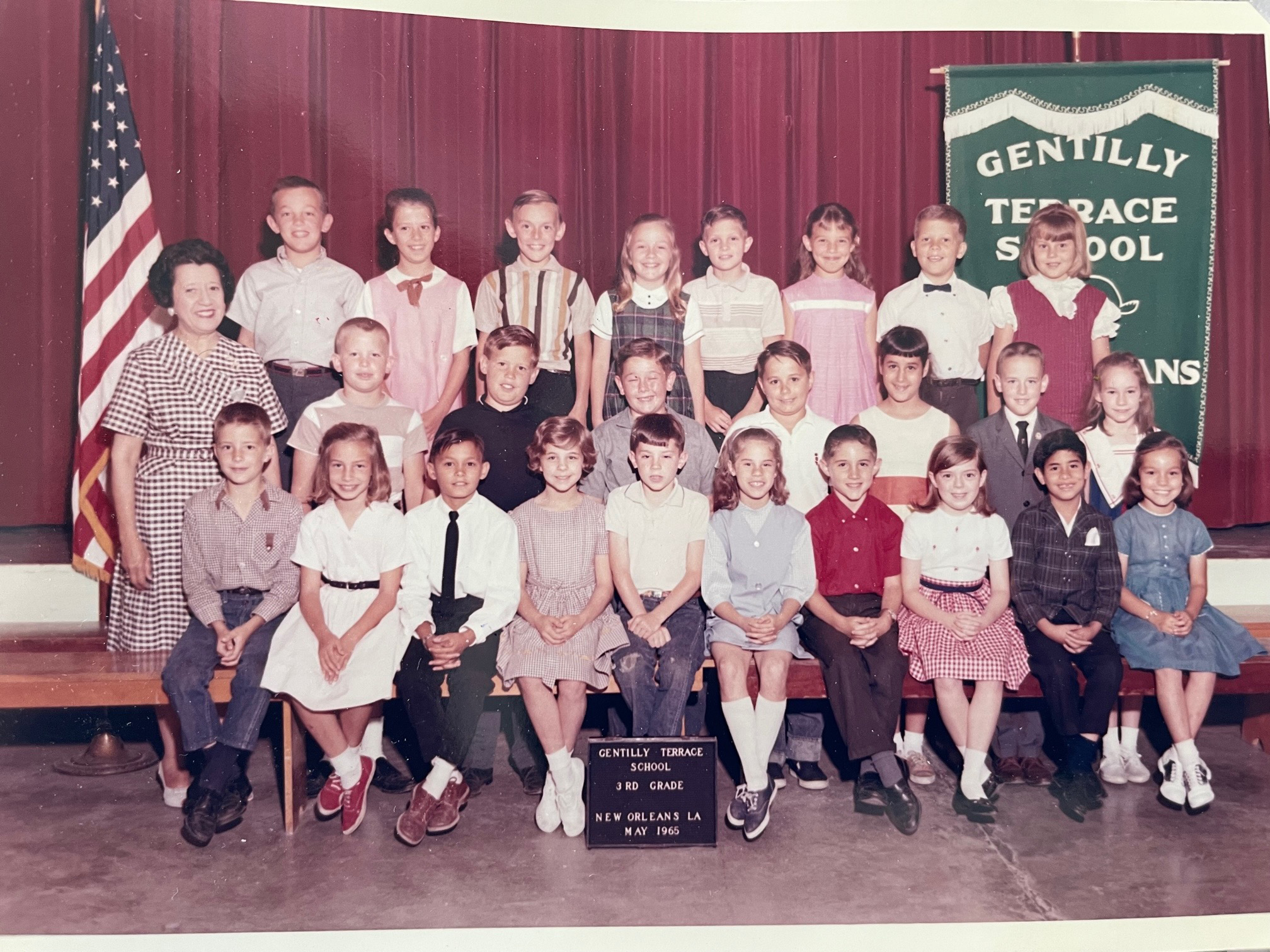
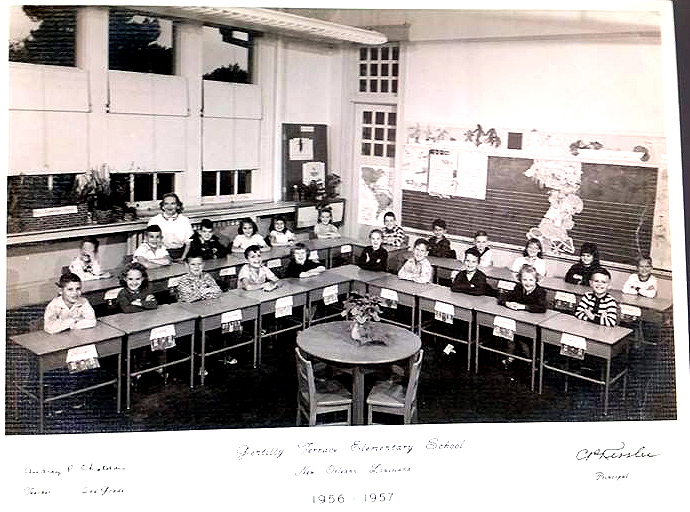
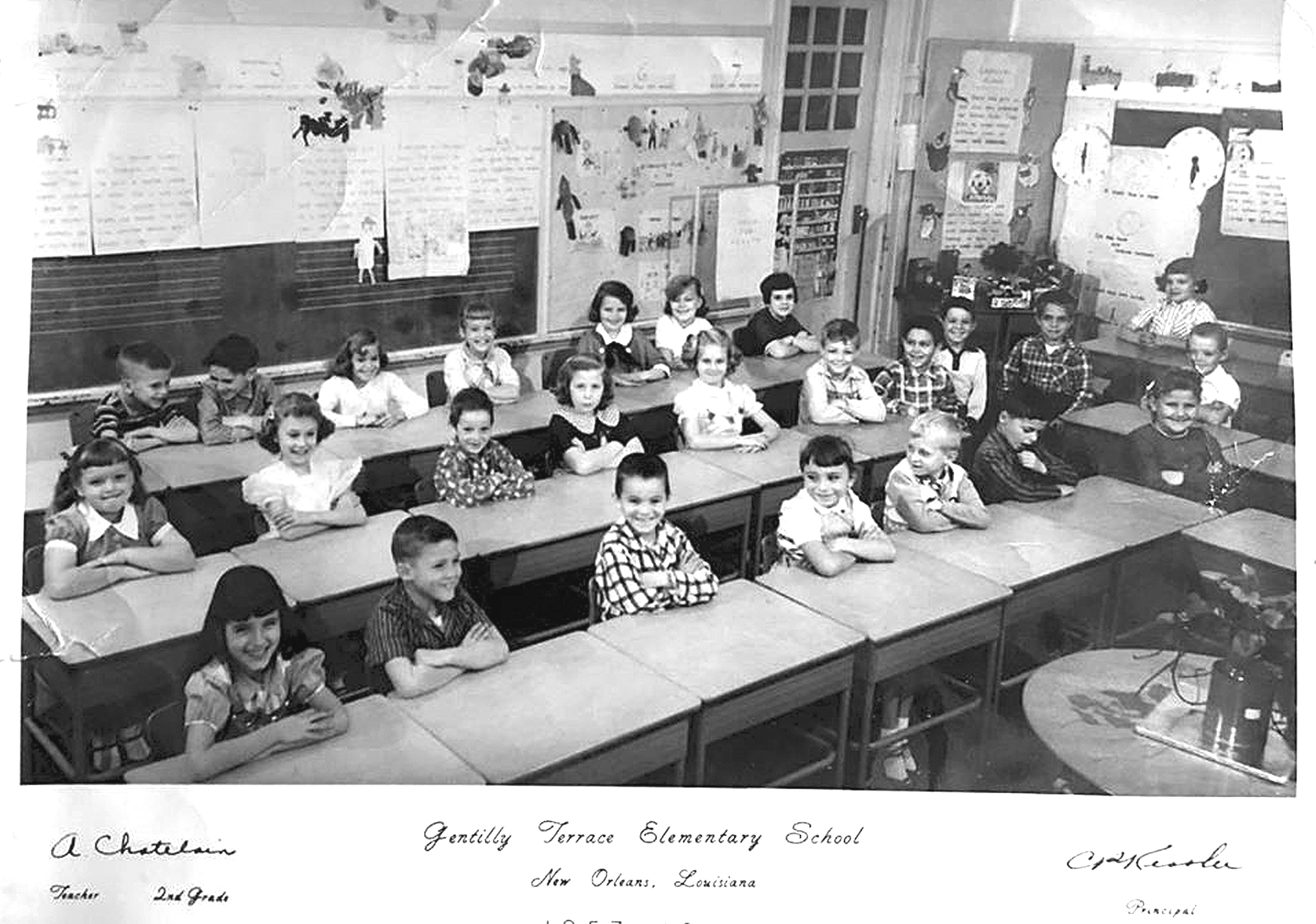
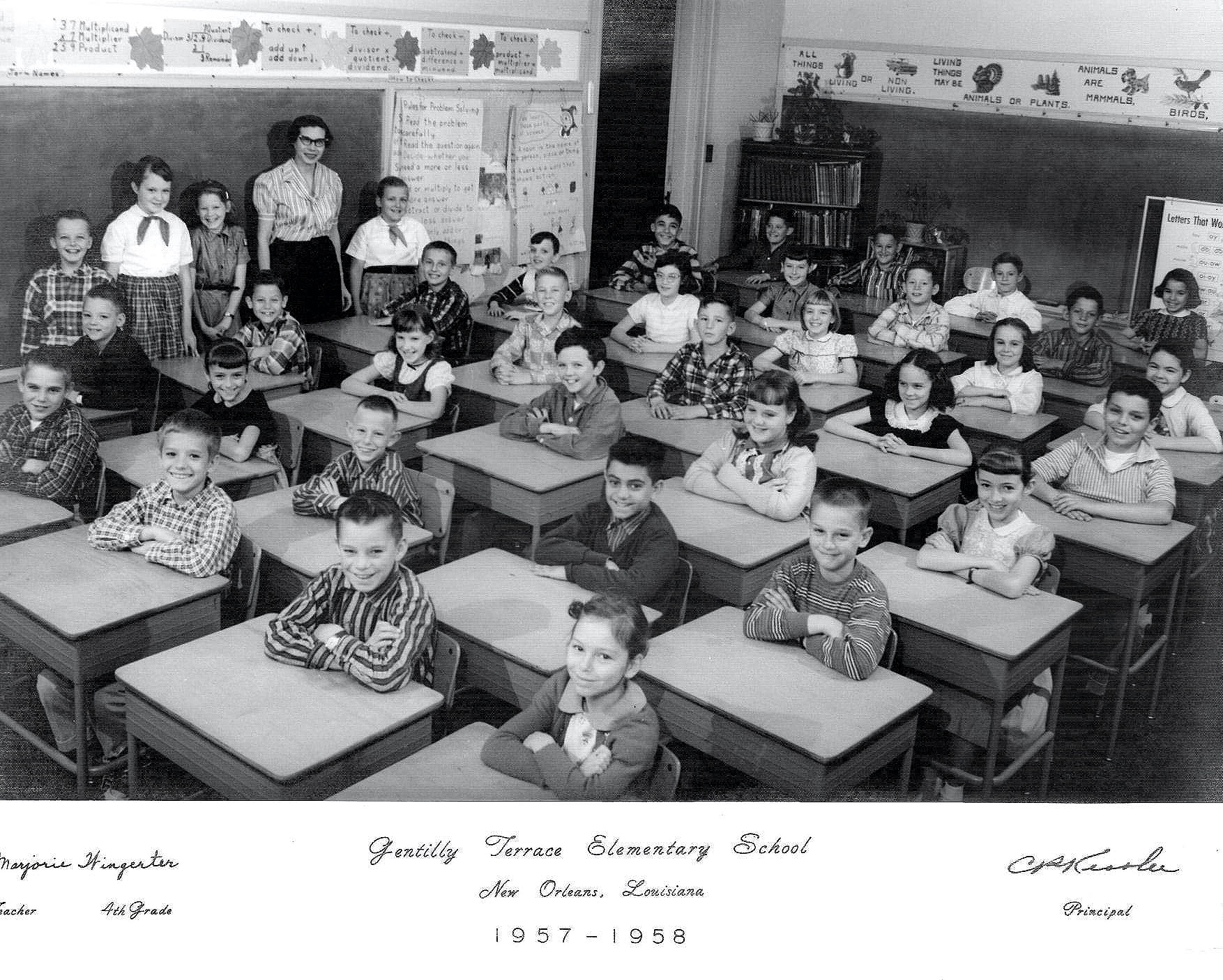
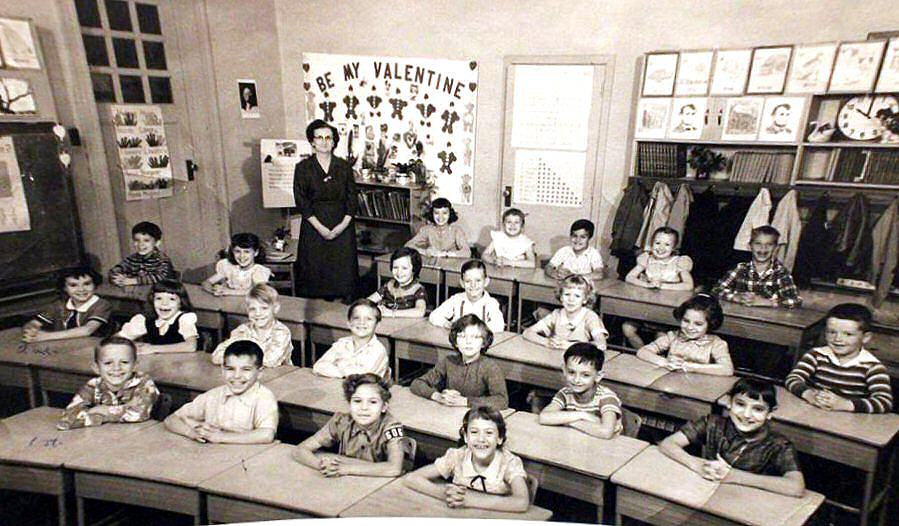
Miss Iva Smith's second grade class from 1956-57
Note the poster behind Miss. Smith. Celebration of Valentine's Day and exchanging of Valentine cards between students was permitted and encouraged in that era. The classroom, which was on the Arts St. end of the building toward Carnot St., was previously used as the Home Economics room prior to the 1953-54 changes. The door to the right of Mrs. Smith, in the photo, led to what was the pantry for food preparation products used in the 7th and 8th grade Home Economics courses.
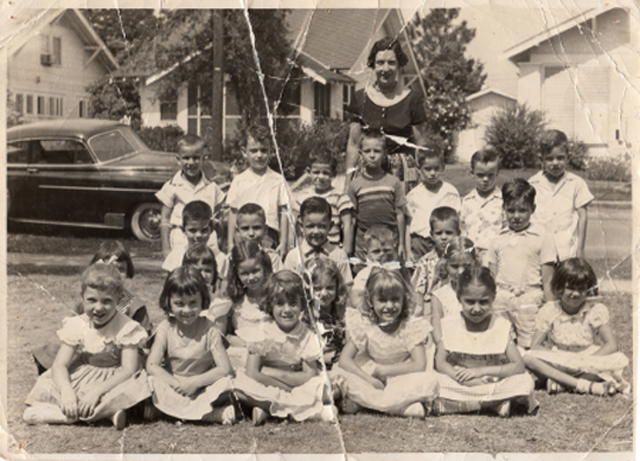
The kindergarten class of Mrs. Mildred Wunder poses on the Painters Street lawn for their annual class picture.
(Photo courtesy of Catherine Mears)
Mrs. Wunder (the former Mildred Gonzales) was one of the remaining Normal School trained teachers. She was also instrumental in organizing the 1930 movement to allow public school teachers in New Orleans to marry. (see note below).
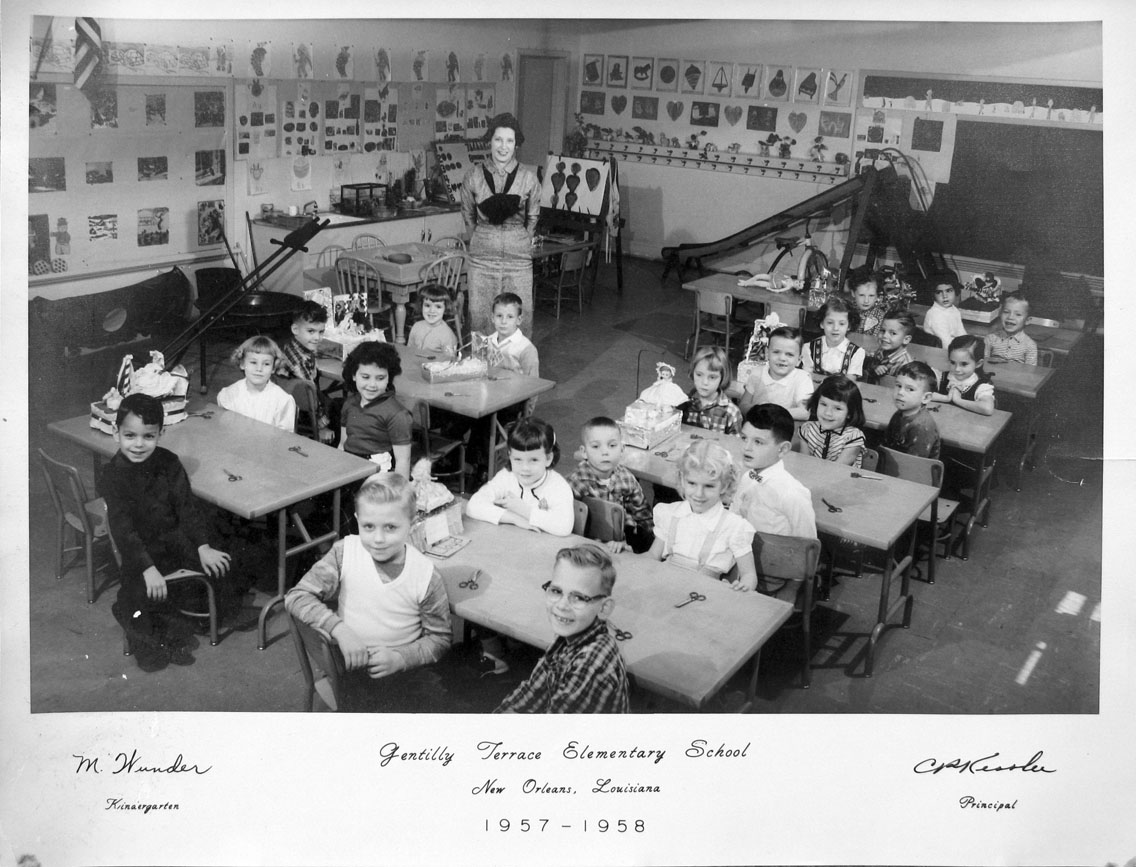
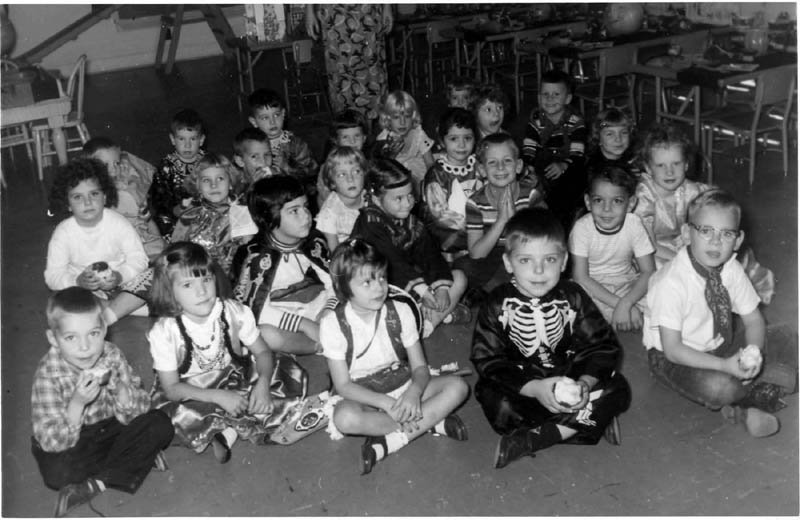
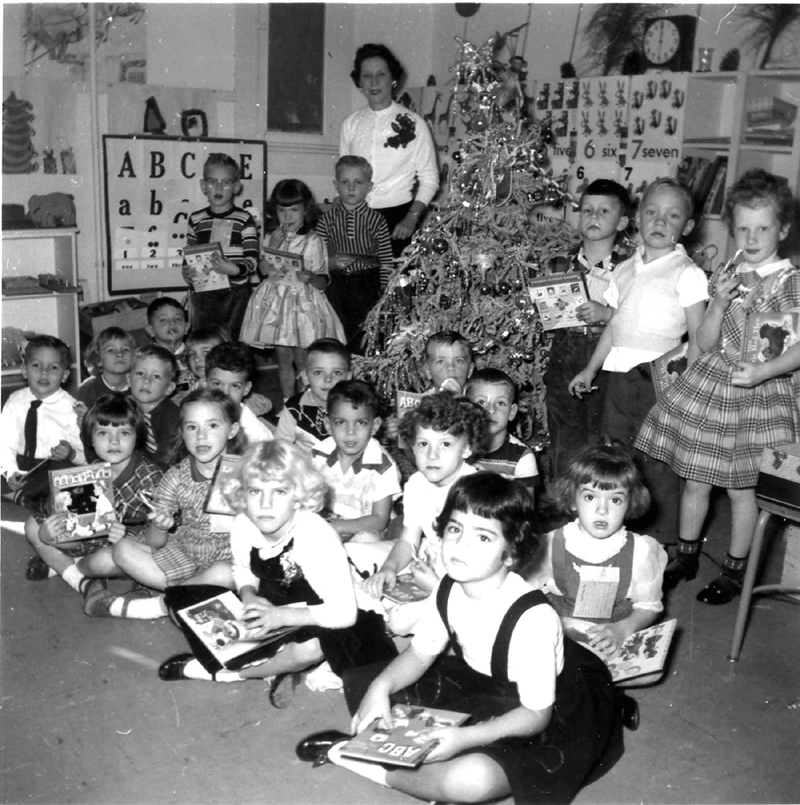
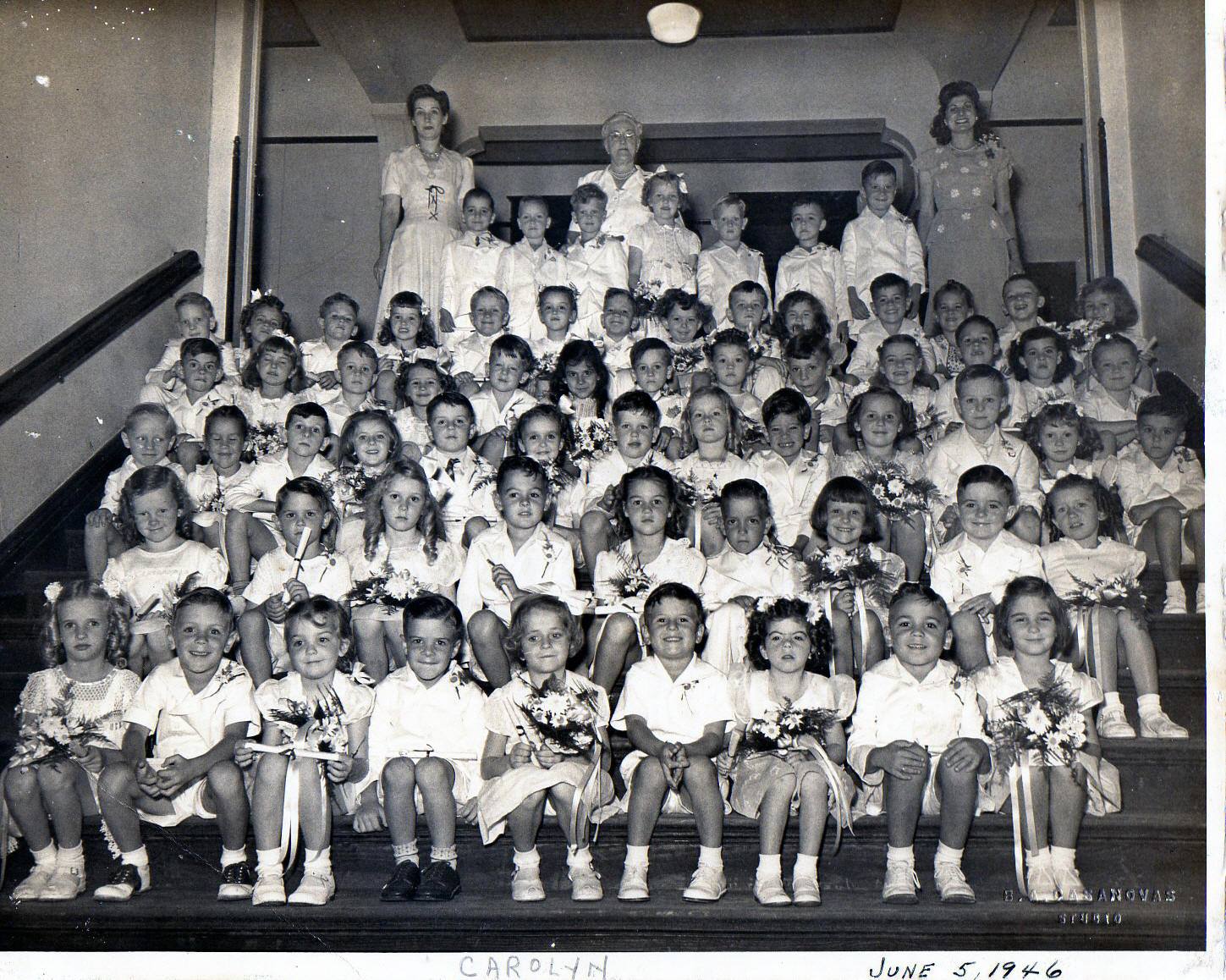
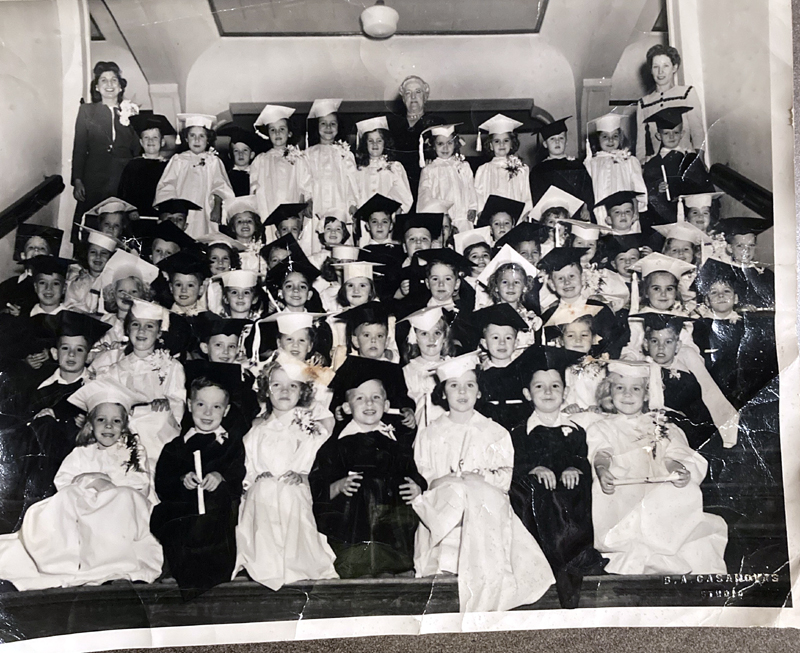
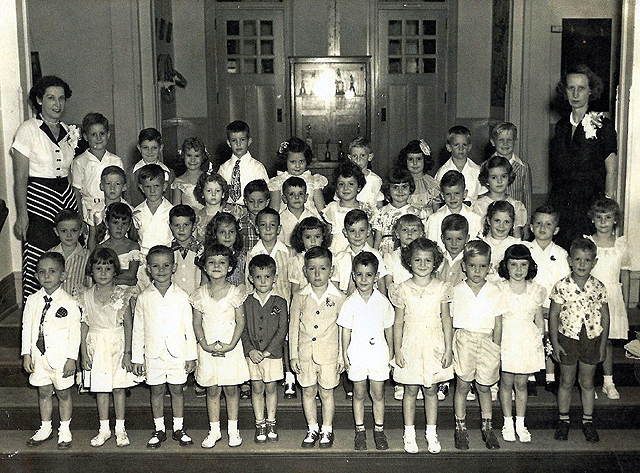
(Photo courtesy of Mr. Bill Creevy)

Another photo of Mrs. Schrenk's class, this time from 1959, thirteen years after the photo above.
(Photo courtesy of Jo Elstner Dunaway)
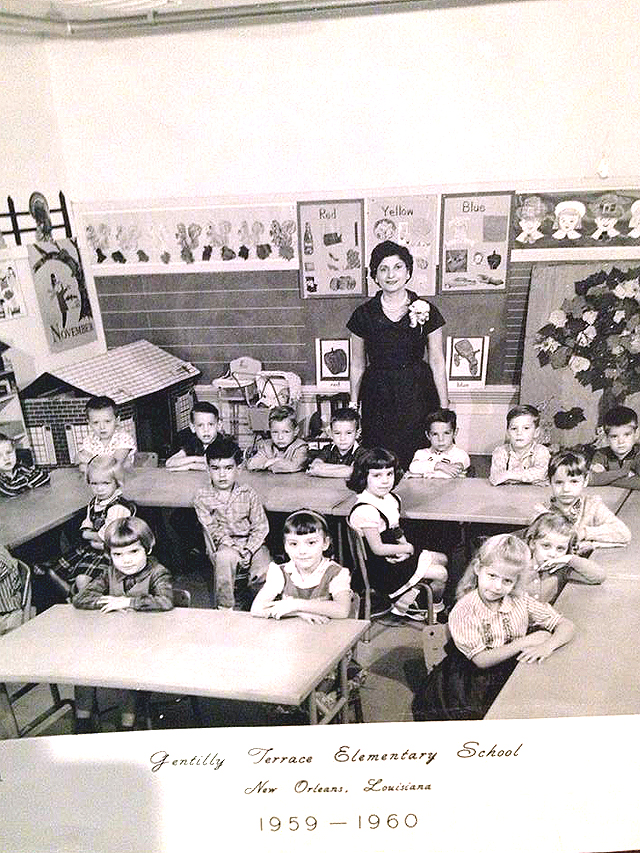
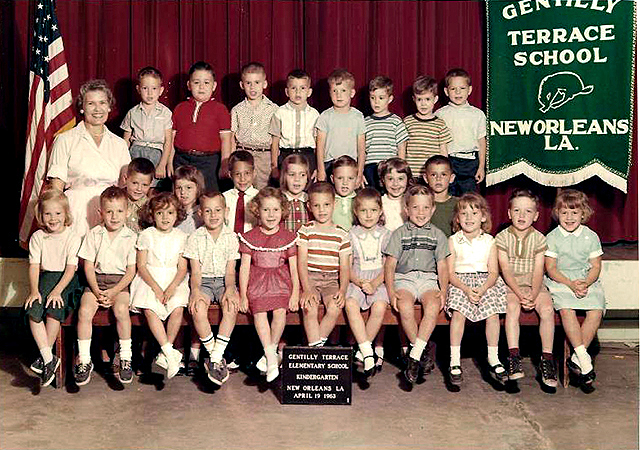
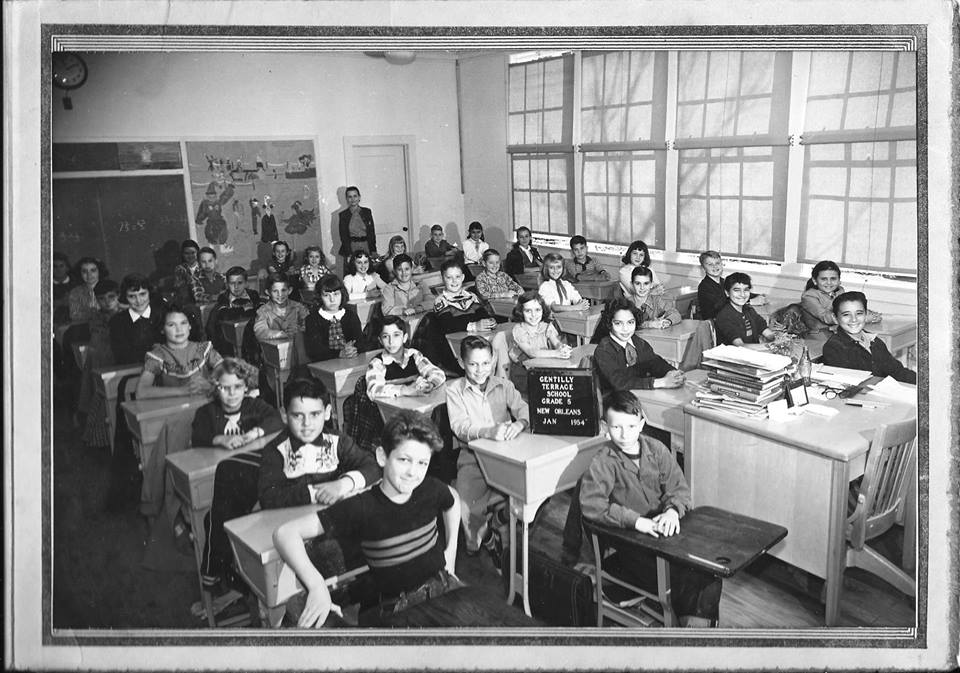
(Photo property of Kathy Boothby Waller)
Shown here is the 1953-54 fifth grade class of Mrs. Ruth C. Stewart. The fifth grade classes were held in the school's Annex building which was located across the playground on the Carnot Street side of the property. Notice that most of the student desks in the Annex were of the older type which were bolted to the floor. Although the main building had been thoroughly renovated in the 1953-54 summer break, the Annex was not given the same treatment. This is evidenced by not only the older generation desks, but also the presence of "school room" style incandescent drop light fixtures visible in the extreme upper right edge of the photo, and the use of gas space heaters in the classrooms.
Here is another trivia question: Look in the rear right corner of the room to the right of Mrs. Stewart. There is a pole hanging from the picture molding. Does anyone remember what those poles were used for? If you don't, the answer appears in the text somewhere on this website.
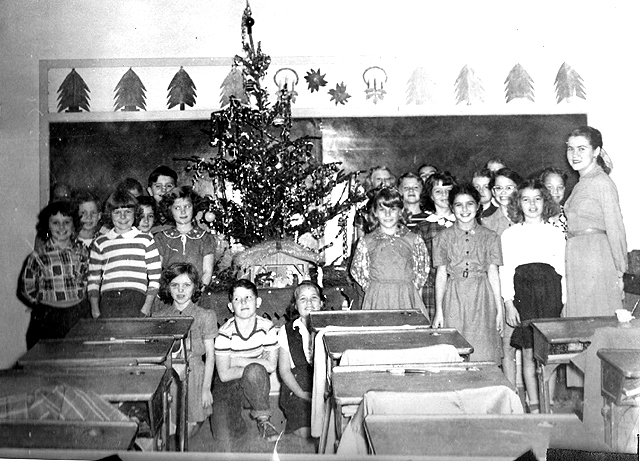
(Photo courtesy of Kathy Boothby Waller)

Photo courtesy of Deborah McShan
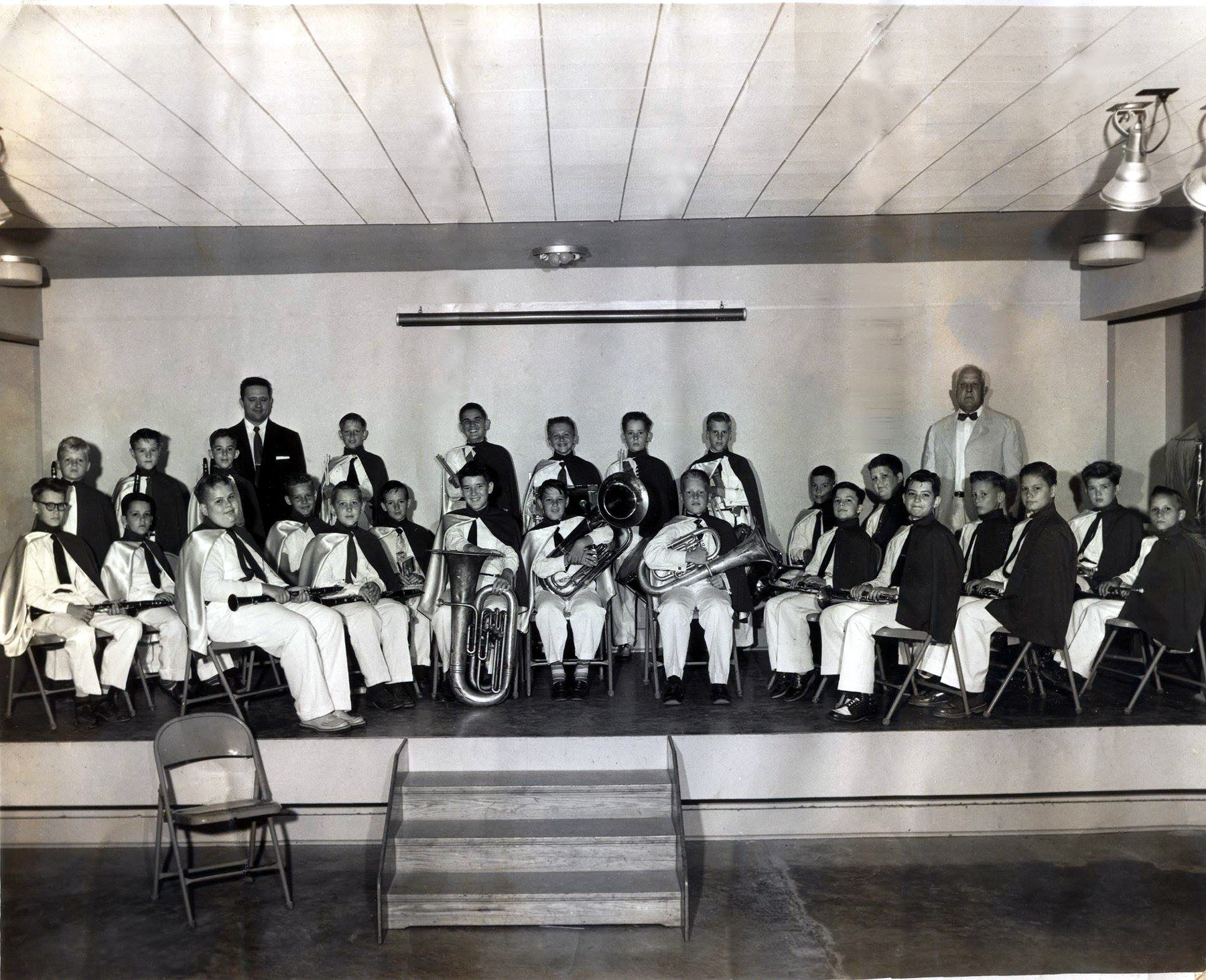
(Photo provided by Roy Mark)
A higher resolution version of this photo can be viewed by clicking on the photo displayed above
A rare photo of the school basement prior to the 1953 renovation and classroom additions. The photo was taken in the assembly area that was in the Painter's St side of the building's first floor. For those who remember this area, the front wall of the building that faces Painters Street was the left side of the photo, and Mrs. Gehrke's kindergarten classroom, which was on the front Painters/Carnot corner of the building, would have been at the rear of the shot. The doors and windows along the right wall, bordered on the play area that was known as the "patio." That was a yard, enclosed on four sides but open to the sky above, which was intended to be a safe play area for lower grade children. It was eventually totally enclosed and roofed, and became the school's auditorium after the summer of 1953. The group shown is the school's BSA Scout Troop 98. The photograph was provided by Mr. Bill Creevy.
For technical historians, the above photo establishes at least a couple of architectural/engineering points. First, this was the general appearance of the school's basement area prior to 1953. In the '53 renovation, this, and the similar open basement area on the Arts Street side, were turned into classrooms. The wood floors, which presented a fire hazard, were removed and fire resistant concrete and vinyl tile floors became the standard on the school's entire lower level. Also of significance are the radiators mounted on the ceiling. Careful study reveals steam traps at various points on these radiators. The reason for ceiling mounting the basement radiators would probably have been to facilitate steam condensate returning, by gravity, back to the boiler room where it was re-used in the heating cycle. When the basement was turned into classrooms, baseboard level hot water convectors, which were encased to prevent the children receiving burns, replaced these more primitive heating devices. The convectors allowed for more careful control of temperature in the smaller spaces of the enclosed classrooms, and were also less unsightly. That improvemet required that the system be converted from steam to circulating hot water, since the baseboard convector placement would have prevented the return of steam condensate to the boiler room without the addition of substantial pumping equipment. Additionally, removal of the ugly ceiling mounted radiators allowed for the installation of acoustic ceiling tile and modern fluorescent lighting.
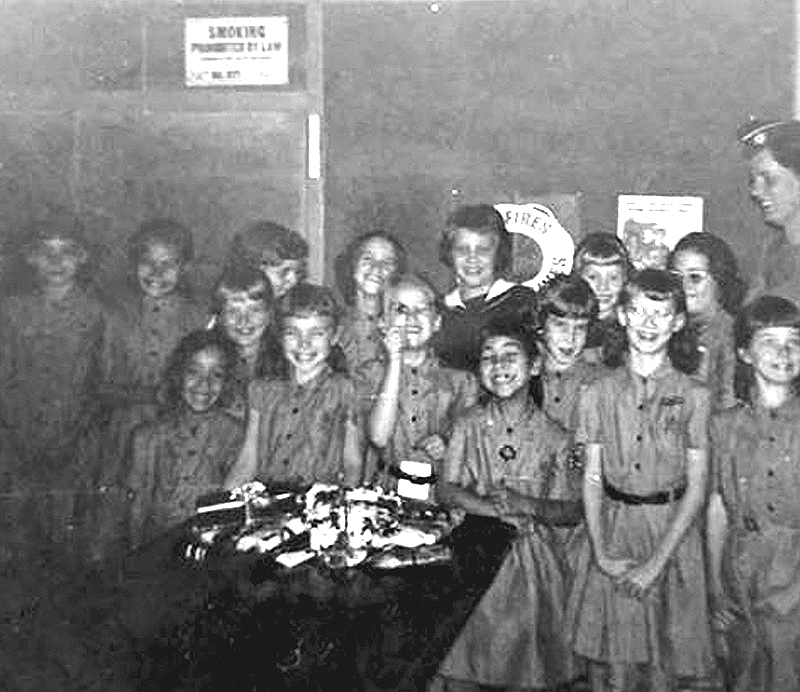
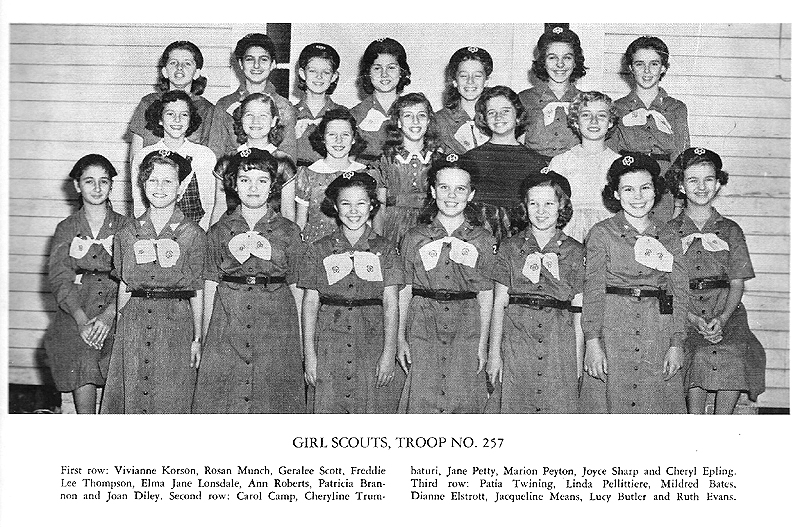
THE GENTILLY TERRACE SCHOOL KREWE OF HEARTS
Each Mardi-Gras season, students were selected from the various grades to participate in the annual Krewe Of Hearts celebration. The festivities included a street parade through the Gentilly Terrace neighborhood, often with the children riding on open convertibles. The court was then presented to the student body in scenes reminiscent of the city's adult carnival krewes. Several photos have been submitted by former students. We are trying to identify what year each photo represents. If you, or someone you know are in an unidentified photo, please let us know the year it was taken so that we can date the photo. We also will post additional photos if they are submitted to us.
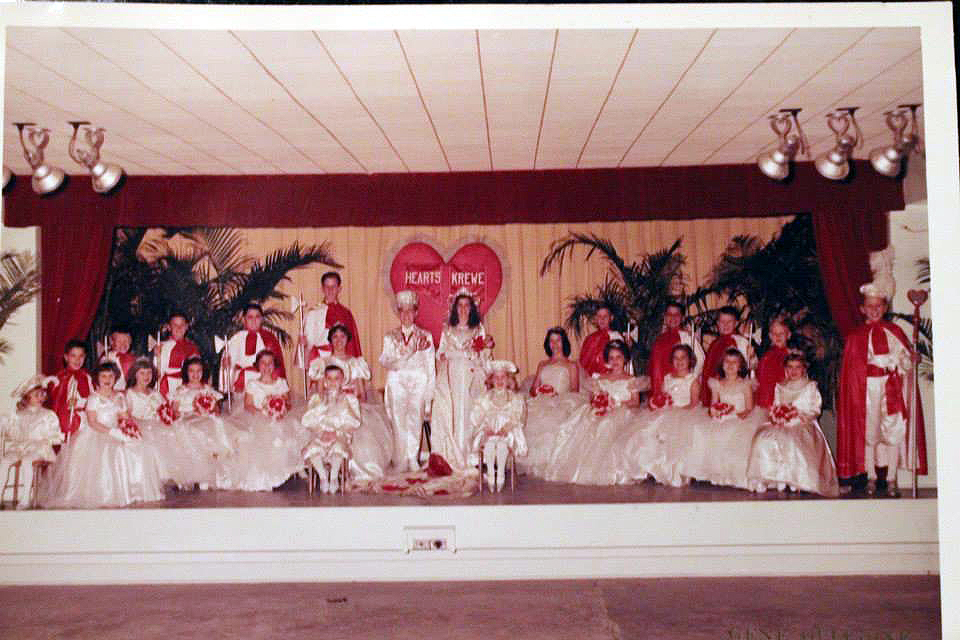
(Photo above: property of Deborah McShan)
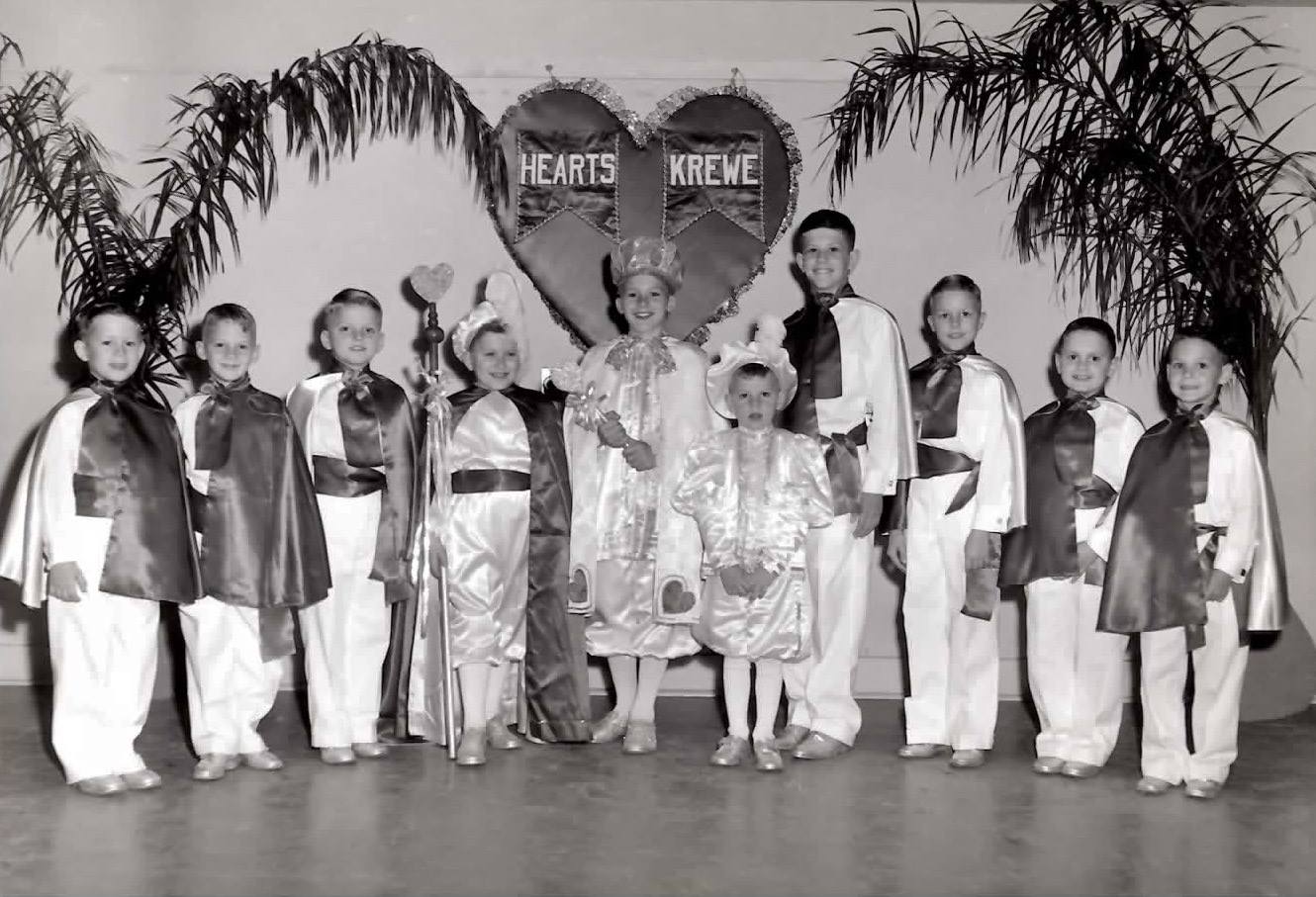
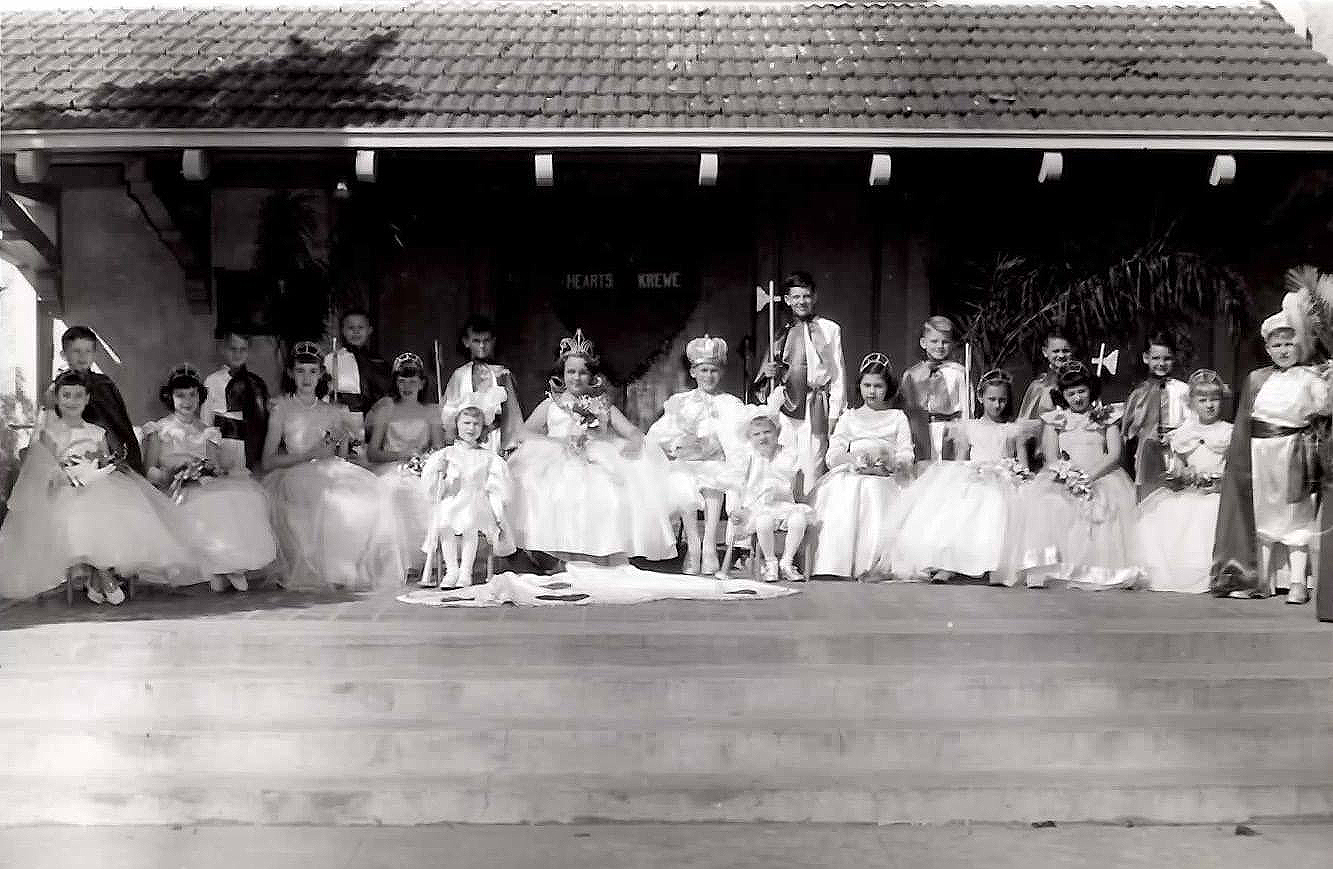
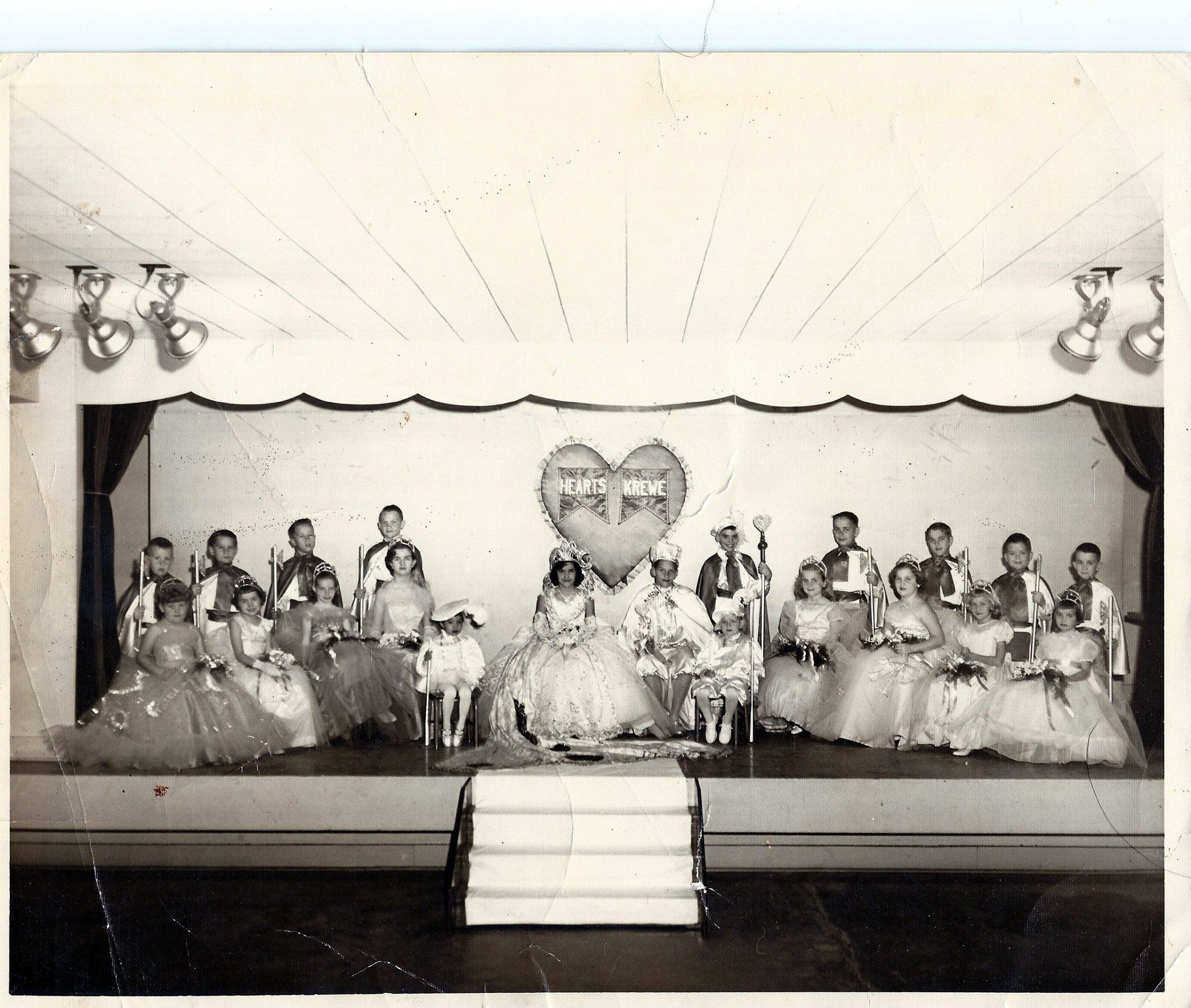
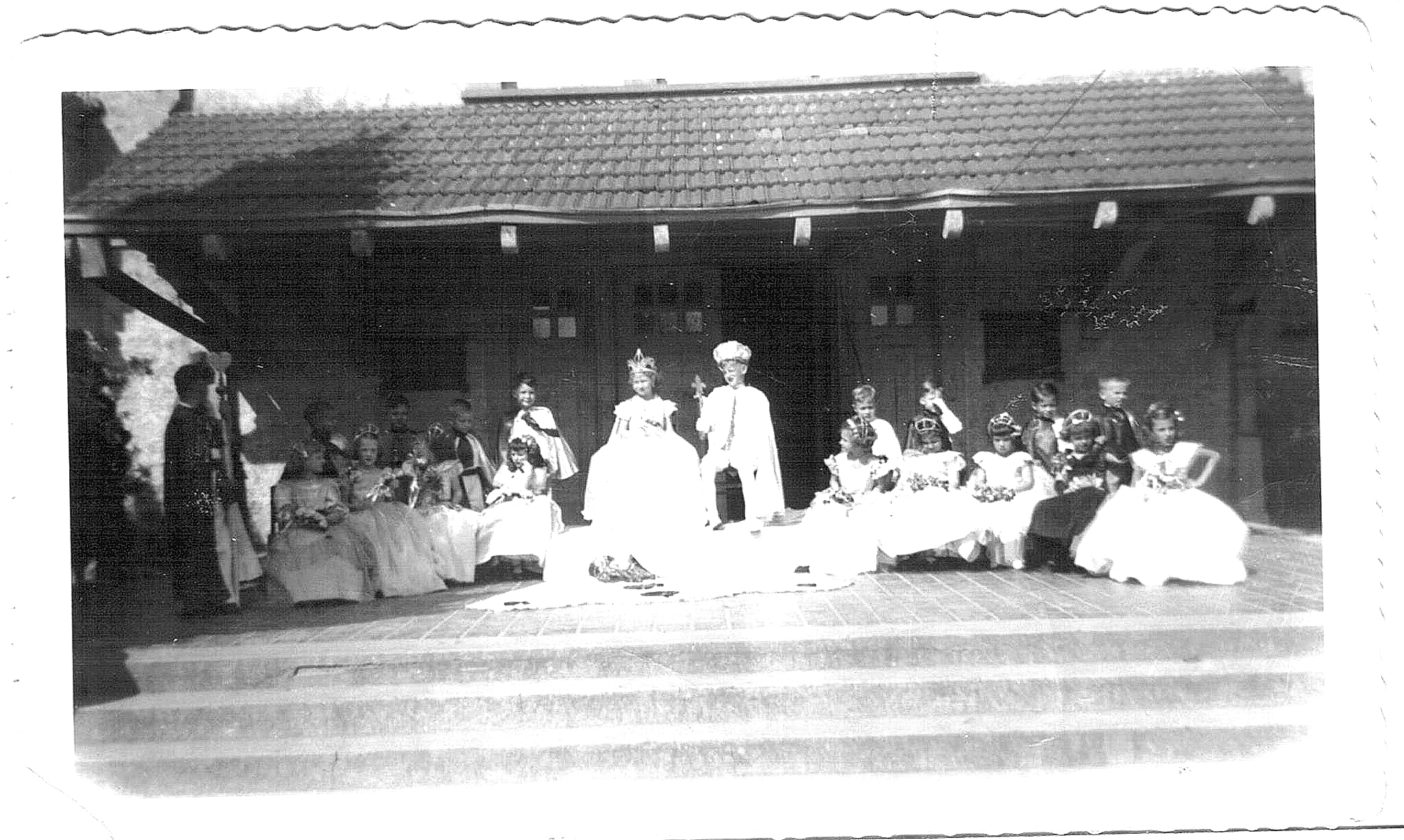

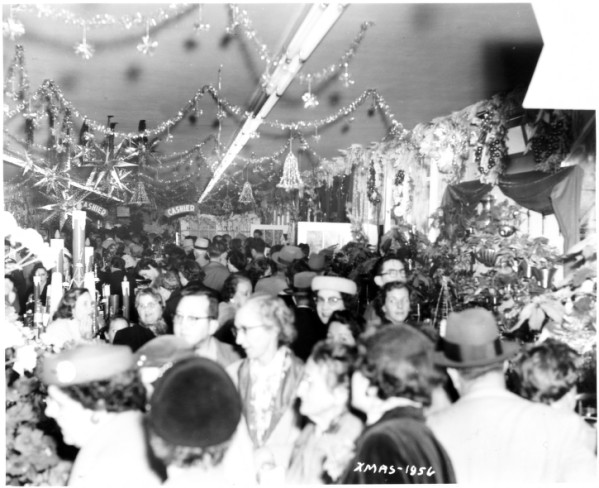

(Photo from the LOUIS Digital Library)
During the administration of Mr. Kessler, the school enjoyed an extremely active Parent Teachers Association and a Dad's Club which also brought many improvements to the quality of education at Gentilly Terrace School. In addition to competitive sports, fund raisers, and an active role by the school in the Gentilly neighborhood community, Kessler also introduced the concept of a student talent show to highlight the many talents of the children who attended the school during that era. The photo above is from the New Orleans Times-Picayune account of a talent show held in December of 1956.
To see a copy of that article, which mentions and shows several performers by name along with Mrs. McWhirter who was the producer, click the photo above.
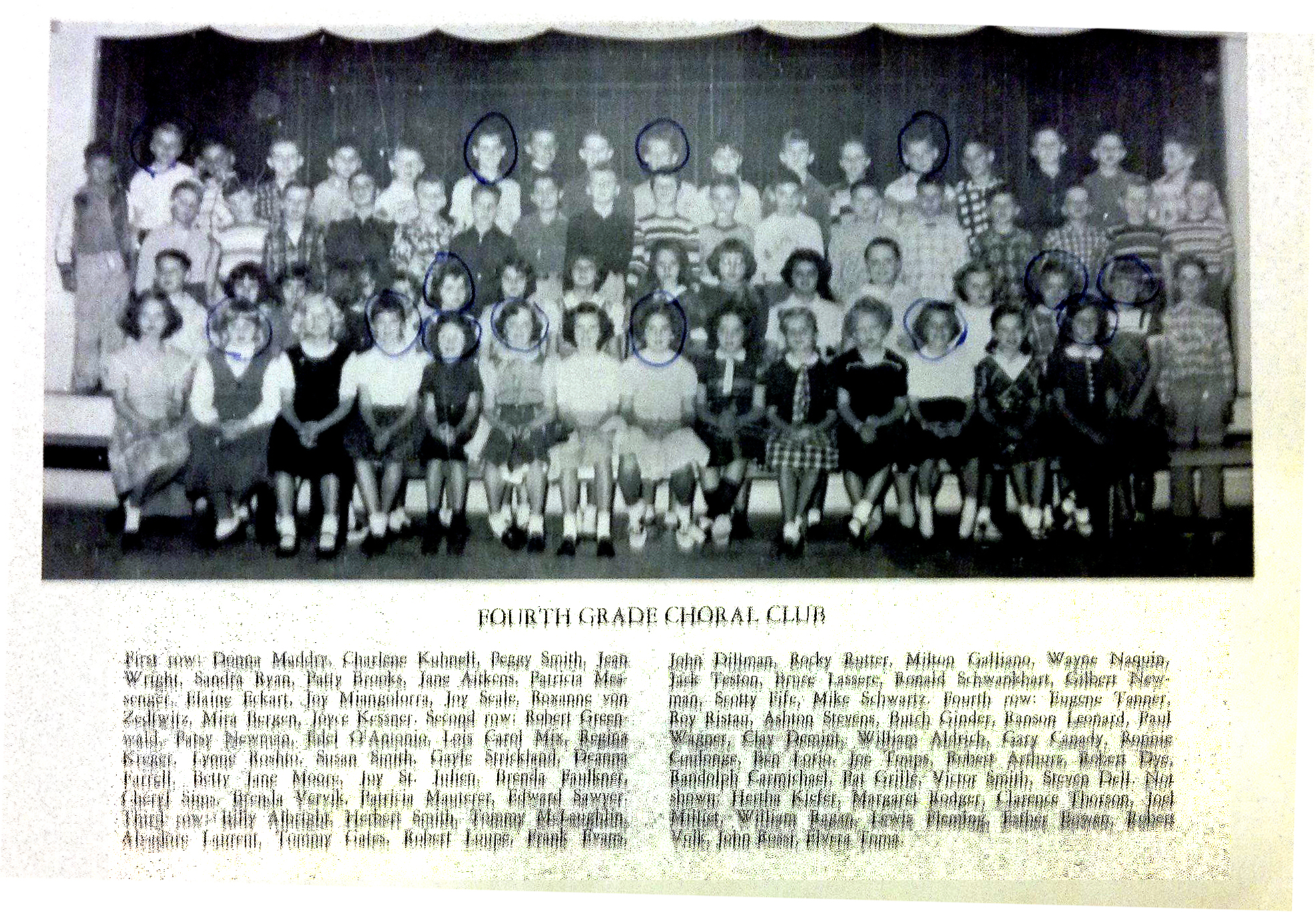
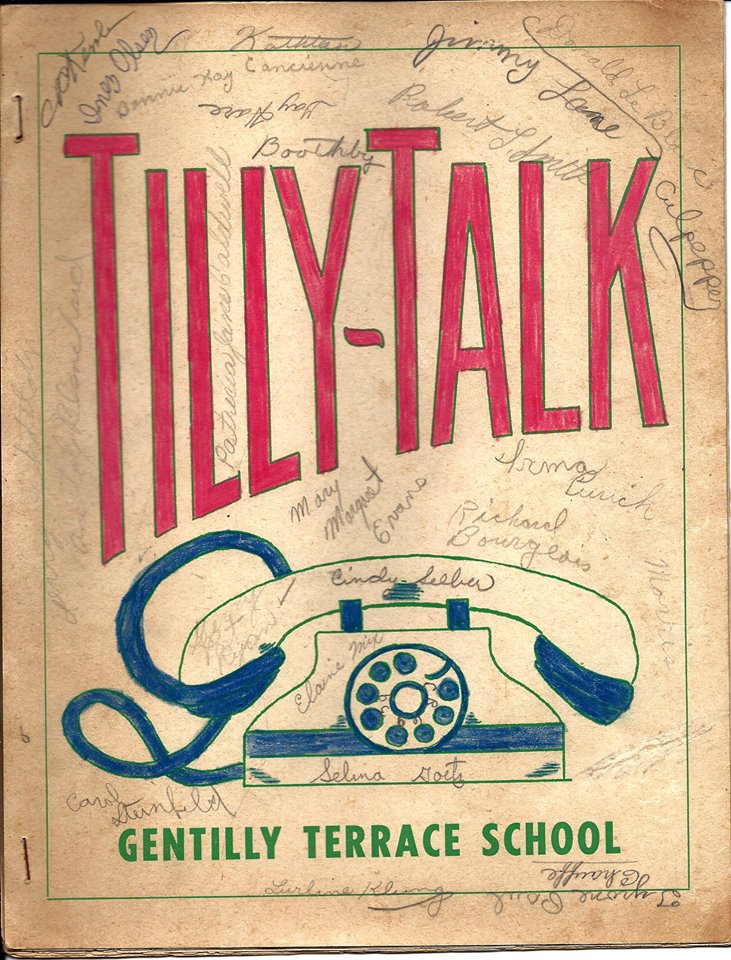
-1301062848.jpg)
(Photo from the LOUIS-UNO collection)
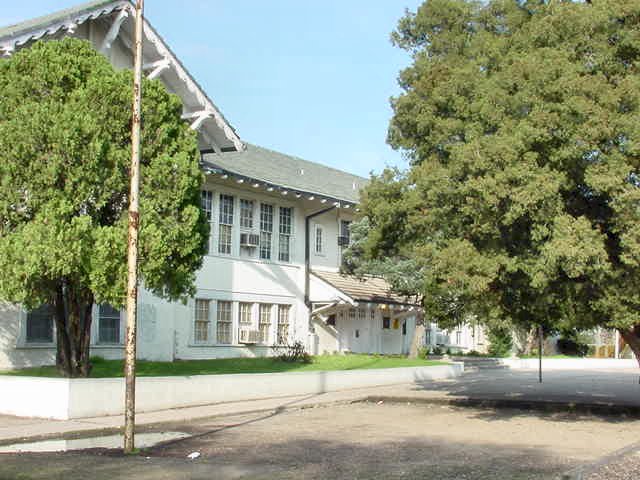
Photo above by John DeMajo
To we children and students, our teachers were these ominous characters who dominated our lives for eight hours every school day. Some we loved, some we feared, but all were respected. Most of us never gave a thought to the fact that these ladies were dedicated educators who were, like our own parents, just trying to survive and earn a living. Some were splitting their time between their duties to their students, as well as raising their own children and caring for their families. Others, who were old enough to have been caught in the draconian regulation of not being able to marry, were on their own to survive, and destined to a home life deprived of the benefits of having husbands and children.
Realizing that many of us knew little about the personal lives of our teachers, we have provided the results of some in-depth research into who these people actually were, and what became of them.
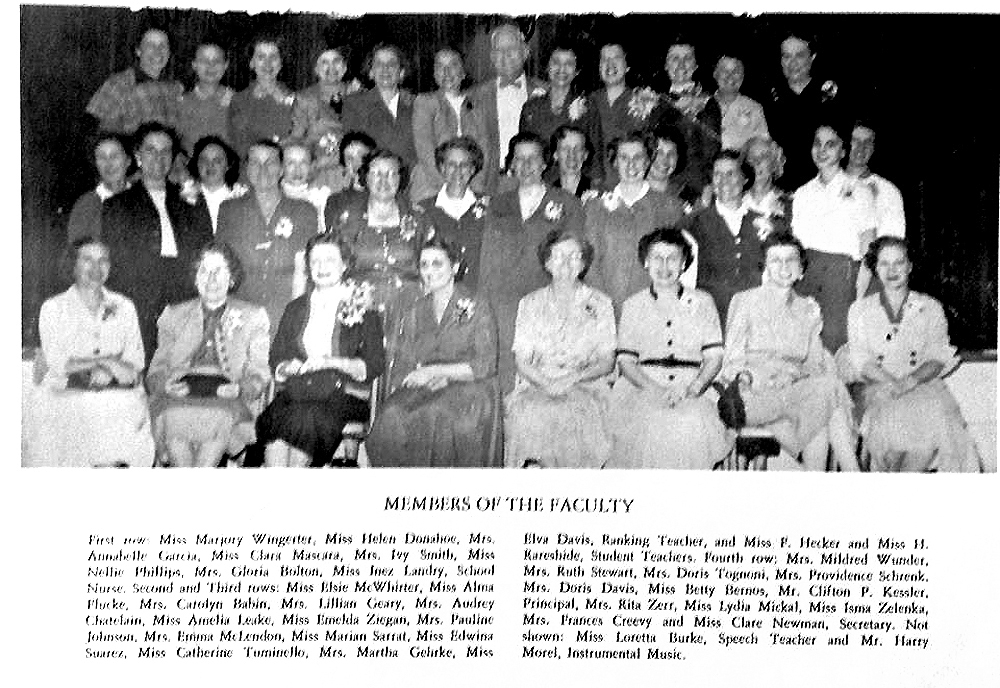
Born March 20, 1901; Died February 17, 1997. She is buried in Metairie Cemetery, Metairie, La
Born Feb. 26, 1919; Died Jan 20, 2013 at age 93 She is buried in Hope Mausoleum in New Orleans
Born Nov. 1m 1909, Died Jan. 12. 2004 at age 94
Born Feb 18, 1908, Died August 5, 1997. She is buried in Greenwood Cemetery in New Orleans.
Second
Lived in Metairie, Louisiana 70005, USA.
Died on October 22, 2000, at age 82.
Born Apr 19, 1909, Died Dec 1987 (buried in St. patrick's Cemetery in New Orleans.
Sixth
(Only photos available through public websites and public domain sources are shown)
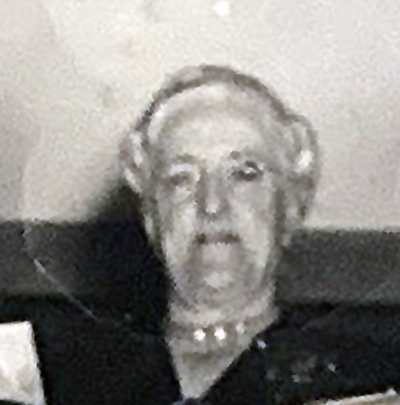
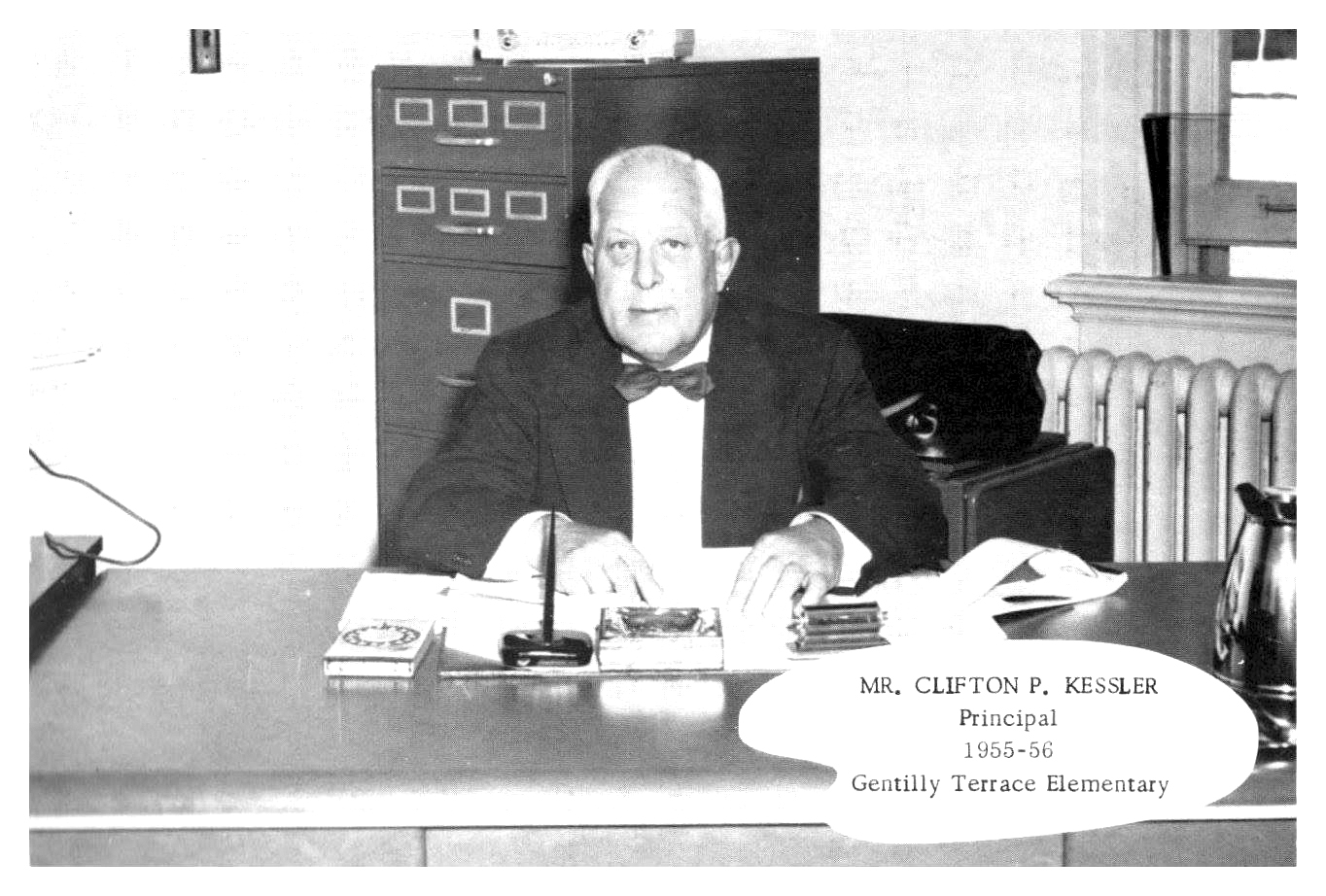
(Photo provided by Roy Mark)
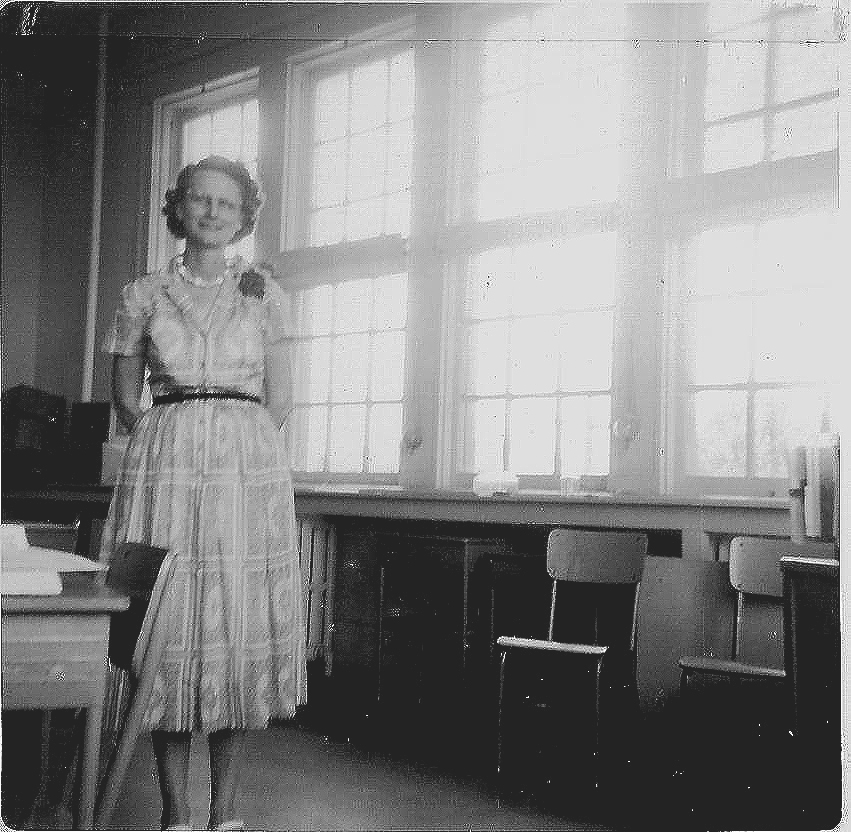
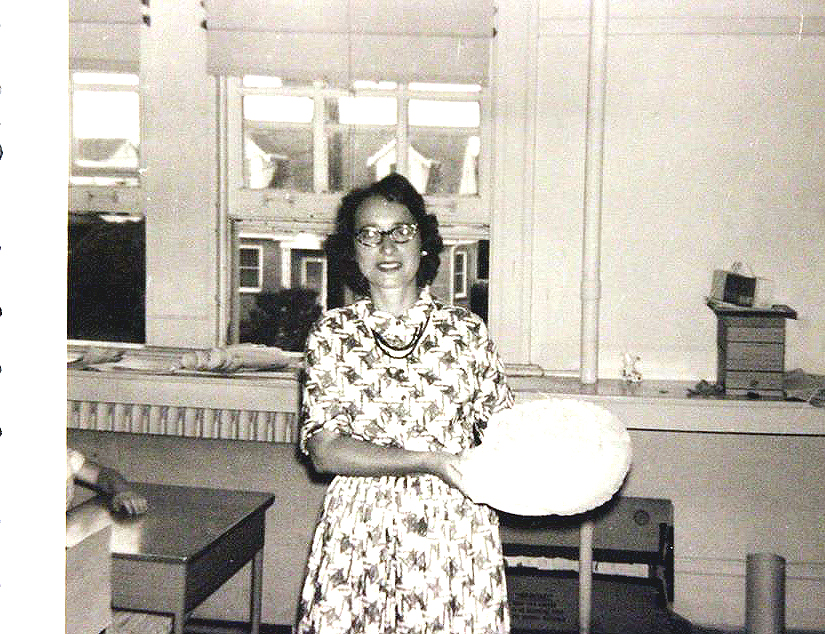
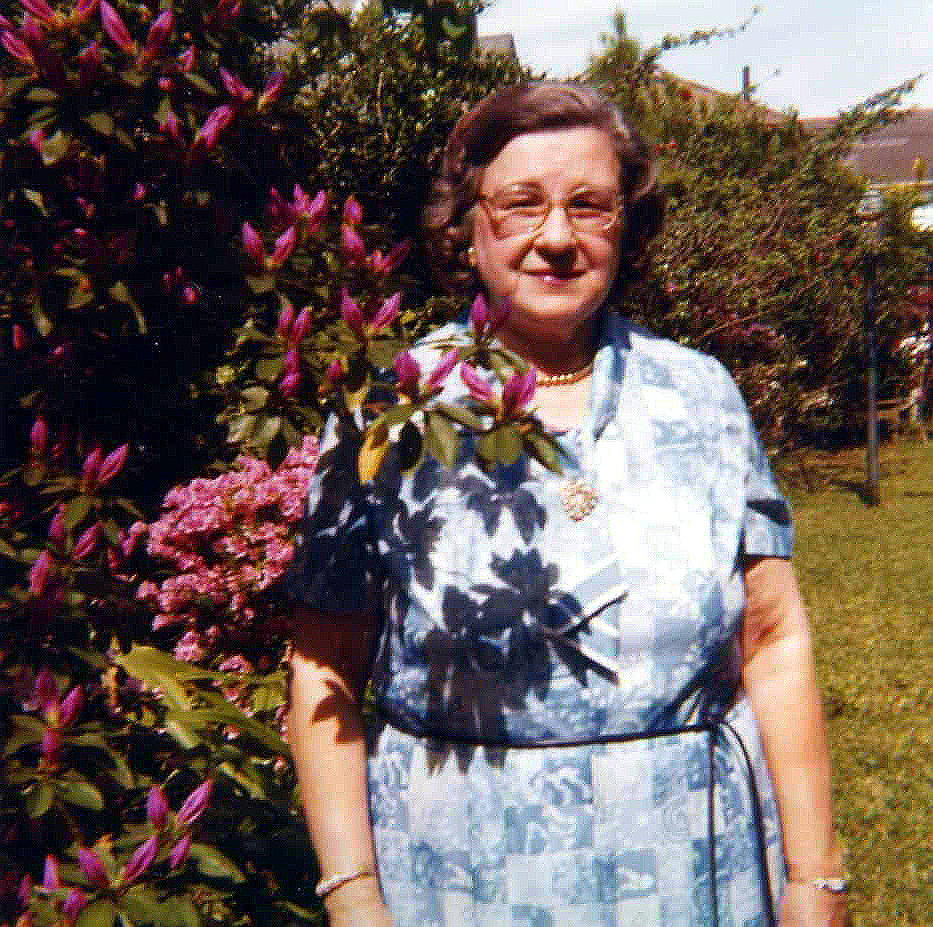
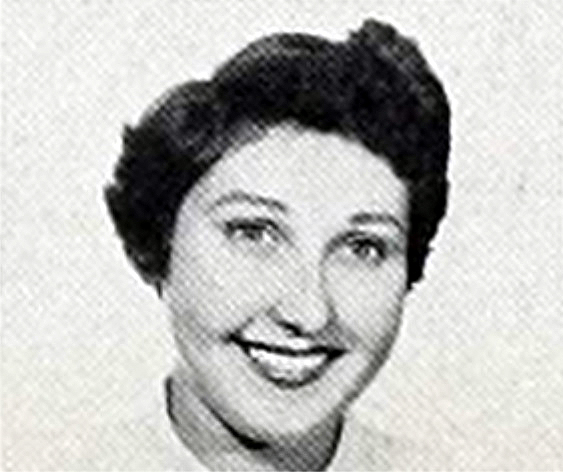
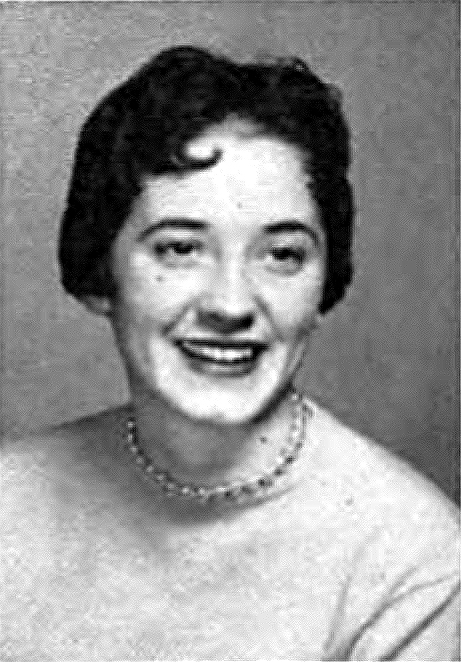

(Photo courtesy of Roy Mark)
SUBSTITUTE TEACHERS
The names that don't appear in the photo above may have been teachers who married and changed last names, or who were hired or left during the years that I was in school. There were also a number of substitute teachers that are remembered. Of course Clare Nevel, mentioned above, substituted in place of Helen Donahoe for almost the entire 1952-53 school year. We also understand that Ms Carolyn Babin's mother-in-law Celine Babin, also substituted for a time when Ms. Babin was on maternity leave. Other substitute names remembered are Mrs. Carla Magee, Ms. Ado, Ms. Lang, Ms Spiller, Ms. Miller and Ms. Schulingkamp, all who were regular subs during the 1950s.
SOME INTERESTING FACTS ABOUT OUR SCHOOL
AND OUR TEACHERS
At the height of the post World War II "baby boom," Gentilly Terrace School typically averaged close to 900 enrolled students. Classes throughout the 1950s usually ranged from 28-33 students assigned to one classroom teacher. At that time, the concept of classroom teacher assistants had not yet been introduced, so each teacher was solely responsible for the education and discipline of the entire class.
Mrs. Mildred Gonzales Wunder (Kindergarten) was the organizer of the 1930s system-wide movement to allow female public school teachers to marry while continuing their teaching careers. Previously, all female teachers were prevented, by the terms of their contracts, from marrying while employed as teachers in the Orleans Parish School System.
Providance (Sue) DiMartino Schrenk was the sister of Mrs. Gertrude Meade who taught Spanish to many GTS alumni at John McDonogh Senior High in the 1960s.
Band director Harry Morel, Sr. was a noted trumpeter who played with a number of big dance bands.
Mrs. Ruth Stewart (5th grade teacher) once taught Mrs. Carolyn Babin (2nd grade teacher) when Mrs. Babin was herself a child in grade school.
Despite having had a serious heart attack in her classroom early in the 1952-53 school year, first grade teacher Ms. Helen Donahoe later returned to teaching, demonstrating the type of dedication to their profession that was common in teachers of that era.
Time at the school was kept first by a large wall mounted clock in the hall across from the principal's office. As part of the 1953 renovation, it was was replaced by a system of IBM wall clocks in several areas of the building. The IBM clocks were networked to a master clock in the principal's office, and the master clock was set through a network from the National Bureau Of Standards in Colorado via Western Union and IBM networks. These new clocks were also capable of controlling the scheduled ringing of the school's bells, which were also strategically placed throughout the building. Prior to the installation of that system, the school had no electric bells, and the old hall clock, across from the principal's office, merely alerted the principal that it was time to have teachers ring brass hand bells, at each corner of the first and second floors, signaling the start and end of classes.
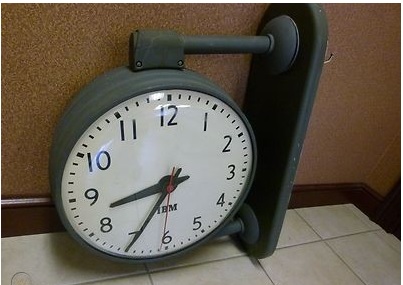
IBM double-face wall clock of the type used in GTS following the 1953 renovation.
And last but not least, Sex Ed, a hot topic in education today, is apparently nothing new according to this February 22, 1936 Times Picayune article involving Gentilly Terrace School. It would be interesting to know whether this met with any resistance from parents of that era:
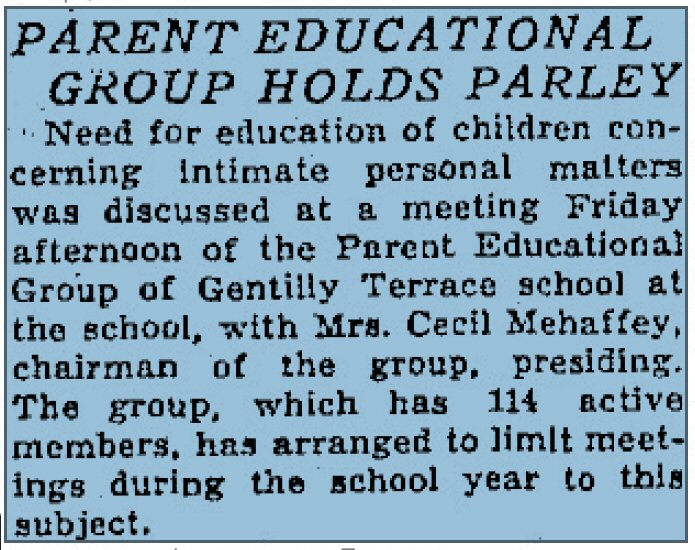
OTHER ARTICLES OF INTREST CONCERNING GENTILLY TERRACE SCHOOL'S HISTORY
October 1914 - New Gentilly school building accepted. Classes to begin
1926 Expansion of GTS building from original eight classrooms
20th Anniversary of school Oct 8, 1934
The great fire of November 1936
30th Anniversary of school Oct 14, 1944
New classrooms to be added October 4, 1946
Retirement of Henrietta Keitz
Demolition of Janitor's house and discussion of over crowding Sept. 1952
DO YOU REMEMBER?
THE 1950's ERA PHONE NUMBERS FOR THE SCHOOL
Up until the early 1950s, the phone number for the office was FRanklin 9931
In the 1950s, when the FAirview exchange was placed on line, the number became FAirview 4012
The Annex had their own phone, which was a wall mounted Western Electric "space saver" phone located on the door between Mrs. Stewart's classroom and the multi-purpose room. The number for that phone was CRescent 1101. The Crescent exchange had been put into operation by Southern Bell at the end of World War II as Gentilly expanded. The Annex, which was opened in 1946, had probably been issued one of the first group of CRescent exchange numbers.
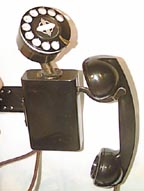
Phone style used in the GTS Annex.
BRASS HAND BELLS
Prior to the 1953 renovation, the school did not have electric bells. Students were called to class by the synchronized ringing of brass hand bells at each corner of the building. Assigned teachers were responsible for ringing the bells in their respective areas.
Each morning, students were summoned by the ringing of the bells, to assemble in the Painters Street side of the basement where principal Isaac R. Foster addressed students from a platform located against the Painters Street wall. Students were required to recite the Pledge of Allegiance, and sing a patriotic song. After this morning assembly, students marched in two-by-two formation, led by their respective teachers, to their classrooms. Following the 1953 renovation, the morning assemblies were discontinued because of the basement having been turned into classrooms. Beginning that session, the morning Pledge of Allegiance and announcements were carried out over the school's new Executone public address system.
FIRE DRILLS AND "DUCK AND COVER EXERCISES"
Until the installation of the fire alarm system in 1953. fire drills and alarms were also signaled by the ringing of hand bells. By mid-1950s, the U.S. Civil Defense Agency required that schools conduct "duck and cover" drills as preparation for the developing threat of nuclear attack by the Soviet Union. Students were instructed to get on the floor of their classrooms and huddle under their desks during these drills. The school's fire alarm system was used to signal "duck and cover" drills by short blasts on the fire alarm horns instead of the steady tone that was used to signal fire drills.
While the Annex had been equipped with fire alarm devices per code in the 1953 renovation, electric bells had not been installed. The main building had IBM controlled clocks and class bells following the 1953 upgrade, but the brass hand bells were still used to call students to class in the Annex throughout the 1950s.
BANK DAYS
Gentilly Terrace School had one of the first college savings plans for students in the country. Instituted by Mr. Foster during the 1950 school year, Miss Michal was given the task of setting up a program whereby students could buy savings stamps, a holdover from the War Bonds program which the government instituted in World War II. When the students filled a book with the stamps, which they were able to purchase for 10 Cents each from Miss Michal in the school basement on the designated "bank day" each week, the stamp books could be converted over to a $25 U.S. Savings Bond in the student's name. Later, when Mr. Kessler became principal, the program was modified and Progressive Bank of New Orleans became a partner with the OPSB schools, thereby offering students a regular bank passbook savings account. Account deposits were still collected by the teachers, and students would have their passbooks updated by a representative from the bank.
KENNETH POTTER'S MORNING PLEDGE TO THE FLAG
For several years following the installation of the new PA system, each morning we would all rise and pledge allegiance to the flag, as led by student Kenneth Potter via the Executone squawk boxes in each classroom.
MRS. GARCIA'S LUNCH TIME SQUARE DANCE CLASSES
Several teachers and parents of Gentilly Terrace students were members of local square dancing groups. Third Grade teacher Mrs. Annabelle Garcia and her husband were one such couple. Mrs. Garcia brought the art of square dancing to the students at Gentilly Terrace by offering square dancing lessons to students who wished to participate during the lunch time recess. The classes were usually held in the school's auditorium.
WINDOW BOXES AND POLES
Our teachers generally assigned classroom duties to students. In retrospect, we see that this was part of their training us to accept responsibility that would carry over into our adult lives. These tasks involved cleaning blackboards, banging erasers at the end of the day, watering plants, and adjusting windows and transoms for good ventilation. As mentioned previously, the school was not air conditioned in the 1950s, and we relied on open windows and the school's high ceilings to make the rooms inhabitable during warm weather.
Prior to the 1953 renovation, the second floor classroom windows were adorned with wooden window boxes. These provided a dual function; allowing students to have a place to grow plants for science training, and to protect against students falling from the huge second floor windows. Under each of the windows, there were usually cast iron radiators which added to the peril. In the 1953 renovation, protective shelf enclosures were provided to shield the radiators so that students would not get burned when passing them. The window boxes were also removed at that time when it was discovered that most were rotting and there was some termite infestation because of the moisture they held.
The casement windows were extremely large double hung sashes that opened top and bottom. Interestingly, there were no screens in use with the exception of the cafeteria windows which were required by code to be screened against flies. For classroom ventilation, long poles with hooks were provided so that the classroom teacher could adjust the upper windows to provide air flow in mild weather. As we advanced into the higher grades, it became the duty of an appointed student to see that the windows were opened and closed at the start and end of the day. The window poles were used to reach the upper sashes. An example can be seen in the photo of Mrs. Stewart's fifth grade classroom above. Here is a thought: with open windows in the classrooms, and no screens, there were never any major complaints of mosquito or gnat bites. One has to wonder whether we were more tolerant, or whether the bug population was smaller back then.
MS. ELVA DAVIS and "LOLLYPOPS"
Sixth Grade teacher Ms. Elva Davis had a punish work favorite that she called "Lollypops." These were long division problems that required what seemed at the time to be an infinite number of long division processes, sometimes taking hours to solve. Of course any student who was fortunate enough to have access to their parent's office comptometer or high end adding machine at the time, could solve the problem in minutes, a fact of life that we all kept carefully hidden from our teacher. Today, students are required to use calculators in school. One has to wonder how teachers like Ms. Davis would have dealt with that development.
MR. KESSLER'S MEAT BALL AND SPAGHETTI FUND RAISERS
Mr. C. P. Kessler had established a reputation for fund raising to assist the school. One of the novel ideas he instituted was semi-annual family dinners in the school's cafeteria. In preparation, many of our mothers would assemble in the school's newly renovated cafeteria kitchen after lunch was over, and they would prepare meat balls and tomato gravy under the supervision of Mr. Kessler and the school's staff cooks. Later that evening, students and families were invited to a sit-down dinner in the cafeteria, the proceeds of which benefited the PTA's projects. One such use of the funds was the purchase by the PTA of electric fans for our classrooms.
WIND-UP ACOUSTICAL VICTROLAS IN THE KINDERGARTEN CLASSROOMS
From the early days of the school through at least the 1952-53 school year, the phonographs used in the three kindergarten rooms were Victor Talking Machine Company wind-up "Victrolas". Teachers had to crank up the phonograph with a hand crank on the side, and hope it would not run out of energy before the record was completed. Records were primarily used to allow stretching exercises and an early introduction to creative dance.
KINDERGARTEN CANVAS COTS AND NAP TIME
Prior to the 1953-54 school year, kindergarten students attended a full 9-3 school day. Following lunch each day, World War II surplus Army cots were brought into the classrooms and students were required to nap for an hour. When not in use, the cots were stored in the space under the Arts St. stairway across from Mrs. Wunder's classroom. This practice was discontinued with the start of the 1953-54 school year when Kindergarten classes went to half-day, with shifts of morning and afternoon students.
KINDERGARTEN SINGING EXERCISES PRIOR TO 1953
Prior to the 1953 construction of the school's auditorium, and the hiring of a part-time singing teacher that same year, children in the three kindergarten classes would go on Wednesday mornings into the classroom of Martha Gehrke to be taught simple children's songs. Mrs. Gehrke was a trained pianist, and she had an old upright piano in her classroom that she used to accompany the singing. Students from Mrs. Wunder's and Mrs. Schrenk's classes sat on the wood floor while Mrs. Gehrke's students remained at their regular table seats. In that era, kindergarteners were seated at a series of tables in each classroom. It was not until the 1953 renovation, that individual desks were provided to kindergarten classrooms.
Here is a comprehensive time line on the school's history through the 1950s:
1900 - The New Orleans Sewerage and Water Board is established. Land north and east of French Quarter is drained and made usable for residential development. Gentilly Ridge provided dry land even before this, so it was prime land for future expansion.
1911 - Gentilly Terrace Land Development company was formed and plans released for new residential area north of Gentilly Road.
1913 - Plans made for a school to serve residents of new real estate development known as Gentilly Terrace.
1914 - In October (one month behind schedule) the new Gentilly Terrace School opens as an 8 classroom facility. Initial enrollment was 62 students. Henrietta Keitz, a Normal School trained teacher, is assigned as principal and one of three teachers.
1926 - Gentilly area population growth in the 1920s requires that the school be expanded. Two wings of eight classrooms each are added.
1934 - The school celebrates 20th Anniversary under the direction of Miss Keitz. Enrollment is listed at 600 students
1936 - In November of 1936, the school suffers a devastating fire caused by the heating boiler's chimney. Children exit the building without injury, but school is badly damaged. Students are placed in temporary quarters and repairs to building take remainder of school year to complete.
1941 - World War II brings exponential growth to Gentilly because of construction of defense facilities and defense employee housing, extension of Elysian Fields Avenue, and reclamation of land along lakefront.
1944 - School celebrates 30th Anniversary still under the guidance of Miss Keitz.
1946 - Critical shortage of school facilities caused by war and post-war development in Gentilly. School's enrollment hits 730 students as classroom and teacher resources are strained. School board begins busing students to other schools. At the same time, basement space and a former bus garage are reconfigured to provide classrooms for manual training and home economics classes.
Miss Keitz retires after 40 years as principal. Isaac Foster is appointed as her replacement.
1947 - A wood frame annex building is constructed on the property in order to relieve over-crowding. School board also undertakes construction of new schools in the area.
1951- School sees another huge population increase as baby boom generation, (babies born after WW-II) are now entering kindergarten.
1952 - 53 Isaac Foster dies shortly after Christmas recess. School's live-in janitor also found dead in building on corner of Mirabeau and Arts St. School board issues plans to demolish janitor's house and to end live-in janitors at public schools. Pauline Johnson, upper grade teacher, is appointed acting principal.
1953 - Summer recess sees total renovation of school building. Classrooms are added in space that was previously open basement. Modern safety systems installed and a new auditorium is built. Cafeteria is substantially upgraded. Seventh and Eighth grades are removed and Gentilly Terrace now houses only grades K-6th. Clifton P. Kessler is appointed principal. Enrollment, despite additional schools being opened, still averages over 800 students. Kindergarten classes go to morning and afternoon shifts, and an additional kindergarten classroom and teacher are added.
1955 - Kessler forms "Dad's Club" to assist PTA in programs to boost the quality of education. Fund raising and competitive sports are introduced. The school also has a structured band and vocal music program.
1957 - First class of post WW-II born students graduates 6th grade and moves on to middle school.
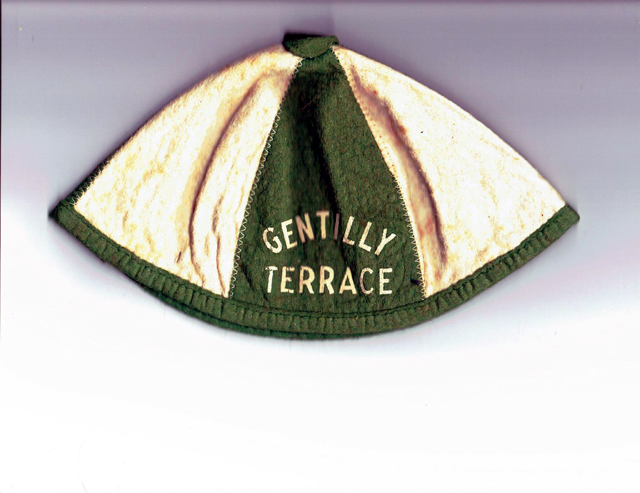
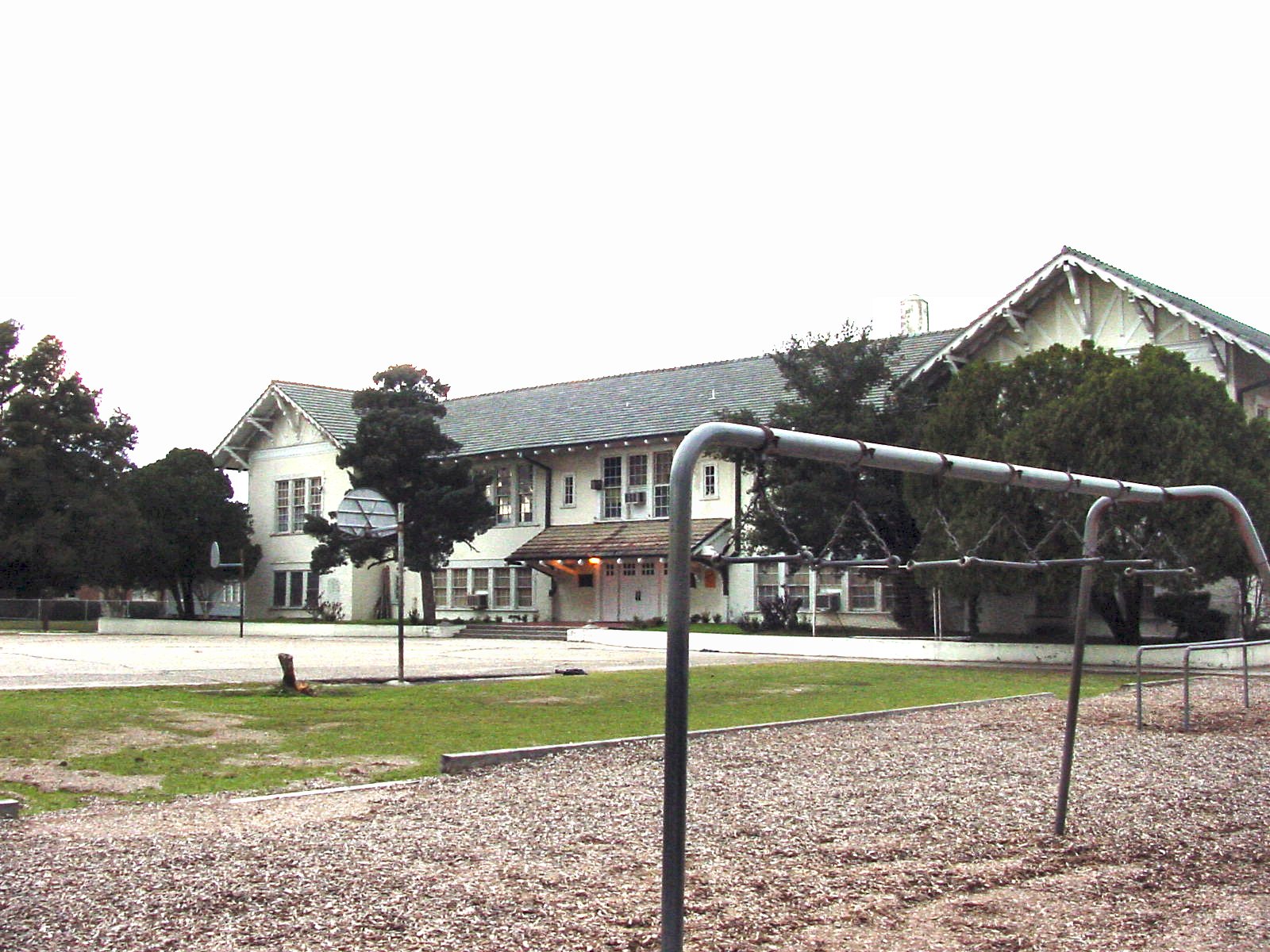
EPILOGUE
My real purpose in creating this site is to assemble a comprehensive history of the school, and to possibly reconstruct some of the little known details that may have been lost as the property evolved and changed management. After opening the site to the public, I received many positive comments from former students indicating that there was nostalgic value as well, and that many memories were being recalled. I hope that this effort will benefit all who visit, whether it be for historical research or just to revive old memories of our childhoods.
Gentilly Terrace School may have been just another school in a large public school system in a metropolitan city, but it represented more than that. Because of its history as a pioneering school in a previously undeveloped area of New Orleans, it was a significant early landmark in the development of a growing city. Its development directly represents the development of both architecture and education in New Orleans. It therefore is, in some way, a reflection of the changes in history that directly bear on New Orleans and its people.
While I drove past Gentilly Terrace School often in my adult life, I had never considered going back to visit until almost fifty years after graduating. It was in the year before Katrina that I awakened one morning and decided that I needed to go back to the old school and close the book on some unfinished memories. In April of 2004, I set aside a morning to do just that, and I drove over to 4720 Painters Street and found my way into the building. Much was the same; the smell of the floor sweep that the janitors used was still lingering in the air, as was the distinctive smell that always emanated from the cafeteria. I went to the office, which was still in the same place and still looked much the same, and I met the principal and office staff from that era. They welcomed me and had one of the ladies give me the grand tour, including the boiler room which I requested to see. While everyone was extremely nice, it struck me that none of these ladies had any knowledge of the history of the school, or what had transpired in the years when we were students. Our student records were not in the files there any more, and they did not know the names of the teachers who had been there in the 1950s. They did not even know who Ms. Keitz was, or that she had been a fixture there as principal for forty-years from the day that the school opened in 1914. I was introduced to a few of the teachers, and I noticed that the children were now being taught with "creative" techniques that allowed freedom of expression, rather than the strict 3Rs and discipline that we experienced as students. Much was the same, and yet much had changed. I left with some small amount of melancholy, but yet I was grateful for having had the opportunity to attend Gentilly Terrace, and to have known the teachers and fellow students that I remember.
Today, the Gentilly Terrace we knew is but a memory. The school is now run as a charter school, and the name has been changed. The physical plant seems to be well kept, and the school is getting high marks from the community. Katrina, while devastating the city, did force some improvements in New Orleans, and Gentilly Terrace School seems to have been a beneficiary of the rebuilding effort. As for we, the 1950s era graduates of Gentilly Terrace, I firmly believe that we were the beneficiaries of the best era in the history of New Orleans and the United States, and that we were blessed to have attended the Orleans Parish School Board's premier school with some of the most dedicated teschers the system had to offer.
Life was a lot simpler then, and I am happy that I was there to enjoy it.
Happy Memories!
John DeMajo
Class of 1958
I welcome any additional photographs or additions to the site from those who attended or were involved with the school in the years between the end of World War II and 1958. Please contact jdemajo (@) demajo.net (remove ( ) if you have information that you would like to share.
Operation and maintenance of this website is a project of the Museum Of Yesterday. Our mission is to preserve the history of 20th. Century America. Hosting is provided by DeMajo.net
Copyright © 2023, John DeMajo
